Baby Care & Parenting Blogs

Nishkraman: The Right Time to Take Your Newborn Out
The journey of life in Hindu tradition is marked by a series of sacred rituals known as Samskaras. These rites of passage guide an individual through various stages of life, from birth to death. One of the early Samskaras performed for a newborn is the Nishkraman Sanskara, also known as the "First Outing" or "First Outdoor Ceremony." This ritual is a significant milestone, symbolizing the baby's first introduction to the outside world and the beginning of their relationship with nature and the universe.
What is Nishkraman Sanskara?
Nishkraman Sanskara is the ritual of taking a baby outside the home for the first time. Traditionally, this ceremony is performed in the fourth month after the baby's birth, though the timing can vary depending on regional customs and family preferences. The word "Nishkraman" is derived from Sanskrit, where "Nish" means "out", and "Kraman" means "to step" or "to move." Thus, Nishkraman Sanskara literally translates to "the act of going out."
What is the right time for Nishkramana?
The fourth month is the right time for taking the baby for an outing. Before this, it is too early for a child to step out. Their immunity is also not favourable for their interactions with the world. The ceremony is held on an auspicious day of the fourth month, like an Ekadashi or Pradosh. Some parents conduct the Nishkramana in the second month if the child is healthy and generally in the fourth month. The day chosen should be right according to the positions of the stars of a child. Some parents believe in following the date and muhurat told by their local priest.
Preparing For the Ritual
Rituals of Nishkraman Sanskara
Preparation:
The preparation for Nishkraman Sanskara begins with selecting a suitable day for the ceremony. The family may consult a priest or astrologer to choose an auspicious date and time. On the day of the ceremony, the baby is bathed, dressed in new clothes, and adorned with a small mark of sandalwood paste or vermillion on the forehead as a symbol of protection.
The Ceremony
The actual ceremony begins with the parents, usually the father or a senior family member, carrying the baby outside the home for the first time. The baby is typically taken to a temple, a garden, or any natural setting where the elements of nature—sun, air, earth, and water—are present.
At the chosen location, the baby is introduced to the sun by holding them up in the direction of the rising or setting sun. The parents may recite prayers or mantras, invoking the blessings of Surya (the sun god) for the baby's health and well-being. Some families also offer a small ritual of Arghya, which involves offering water to the sun as a mark of respect and gratitude.
Post-Ceremony
After the outdoor ritual, the family may return home and perform a small Puja (prayer) to conclude the ceremony. This may involve lighting a lamp, offering sweets to the gods, and distributing Prasad (blessed food) among family members and friends who were present during the ceremony.
The ceremony often ends with a feast or a small gathering where the baby is introduced to extended family and friends, marking their official entry into the community.
Scientific Perspective on Nishkraman Sanskara
While the Nishkraman Sanskara is deeply rooted in spiritual beliefs, it also has a practical and scientific basis. Exposure to sunlight is crucial for the synthesis of Vitamin D in the baby's body, which is essential for healthy bone development and overall growth. The ritual of taking the baby outside also promotes early socialization and helps the child develop a connection with nature.
Moreover, by the fourth month, a baby's vision has developed enough to start recognizing shapes, colours, and movements. The experience of being outdoors stimulates the baby's senses, aiding in cognitive and sensory development.
In today's world, while the specifics of the Nishkraman Sanskara may vary, the essence of the ritual remains the same. It is a reminder of the importance of nurturing a child's relationship with nature and the community, and of the timeless traditions that continue to enrich our lives.

Best Gifts for Your Little One's First Birthday
Your baby's first birthday is a milestone filled with joy, excitement, and a touch of nostalgia. That first-year flies by, and before you know it, it's time to celebrate! But when it comes to choosing the perfect first birthday gifts, it can feel a bit overwhelming. You want something special, something they'll enjoy, and maybe something that will make life a little easier for the parents, too. To help you out, we've rounded up some thoughtful and practical gift ideas that will be perfect for your little one's big day.
5 Best Gift Ideas for 1 Year Old Babies
Wooden Gift Box
A wooden gift box filled with baby care products is not only a beautifully presented gift but also a practical one. These baby gift sets often come packed with essentials like baby lotion, shampoo, body wash, and gentle baby oils. As any parent will tell you, baby care items are something you can never have enough of! A set like this can be a perfect way to pamper the little one while giving parents everything they need to keep their baby's delicate skin soft and healthy. Plus, the wooden box itself can be reused for storing toys or keepsakes, making it a sustainable and thoughtful gift option.
Newborn Mustard Pillow
A newborn mustard pillow is another great option, especially for parents who value tradition and care. These pillows are often used to support a baby's head during sleep and help shape it naturally. Not only are they functional, but they are also soft, breathable, and comfortable for babies. If you're looking for a gift that's both practical and rooted in tradition, this is a great pick. It's something parents might not think to buy themselves, but they'll be thankful to have.
Glass Feeding Bottle
You might think, "Don't they already have enough feeding bottles?" Well, here's the thing: there are never enough! Babies go through bottles faster than you can imagine, and having an extra glass feeding bottle is always a lifesaver. Glass bottles, in particular, are popular because they're durable, easy to clean, and free from harmful chemicals. Unlike plastic bottles, glass ones don't absorb smells or stains, which makes them a favourite among many parents. Plus, they can last longer, making them an eco-friendly option. So, if you're stumped on what to get, a well-designed glass feeding bottle is always a smart and useful gift.
Baby Clothing
When it comes to baby clothing, you can never go wrong with a set of adorable bodysuits or rompers. Babies outgrow clothes faster than we'd like, and having extra outfits on hand is always a plus. Soft cotton bodysuits are a must-have in every baby's wardrobe – they're easy to put on, comfortable, and great for layering. For a first birthday, you could even choose clothing with cute prints, bright colours, or fun themes. Whether it's cosy pyjamas, lightweight rompers for warmer days, or stylish little jackets, baby clothing is always appreciated by parents. Just make sure to pick sizes slightly larger so the baby can grow into them!
Baby Toys
You can never underestimate the joy that baby toys bring! At this stage, babies are curious and love to explore with their senses. A soft toy like a plush little doll or a monkey soft toy can provide comfort and become a companion during naps. Rattles are also fantastic for this age, as they help babies develop hand-eye coordination and stimulate their auditory senses. Look for baby toys that are safe, soft, and colourful. Toys that encourage sensory play, like textured soft toys or musical rattles, are perfect for this developmental stage. Whether it's a squishy stuffed animal or a fun little rattle, toys make great gifts that will engage and entertain.
Final Thoughts
Your little one's first birthday is about more than just gifts – it's about celebrating their growth and all the little moments along the way. The best gifts are the ones that show thought and care, and they're not just about the items themselves but about how they contribute to the joy and memories of the day, whether you're a relative, family friend, or parent. And remember, you don't have to go overboard. Sometimes, the simplest gifts are the ones that mean the most.
So, as you pick out those first birthday gifts, think about what will make a difference in their daily life – because those are the gifts that truly shine.
In the end, what matters most is the love and care that goes into choosing the gift. Whether it's practical or sentimental, a well-thought-out gift adds to the joy of celebrating such a special occasion. As you watch the little one blow out their first candle, you can feel proud knowing that your gift will be part of these treasured memories. It's not about the price tag, but the thought and care that you've put into choosing the perfect gift for your little one.

Best Ways to Get Rid of Mosquitoes This Monsoon
Monsoon brings the refreshing smell of rain, cooler temperatures, and beautiful greenery. But along with all this goodness comes something not so pleasant – mosquitoes. These tiny pests are more than just annoying; they can also carry serious diseases like dengue, malaria, and chikungunya. And if you have infants or young kids at home, the concern is even greater. Keeping them safe from mosquito bites becomes a top priority. But don't worry! In this blog, we'll explore the best ways to get rid of mosquitoes this monsoon, focusing on safe and effective solutions for everyone, especially your little ones.

-
Use Natural Mosquito Repellents
One of the safest ways to protect your baby from mosquitoes is by using a mosquito repellent for infants that is free from harmful chemicals. Mosquito repellents come in various forms – sprays, creams, and patches. However, choosing the right one for your little one is crucial. Look for natural options that use plant-based ingredients. For instance, Baby Forest's Mashak Kawach Baby Mosquito Repellent Spray is a great choice. It's made from a 100% natural blend of essential Ayurvedic herbs like Bhustarah (Lemongrass oil), Cedarwood, and Lavender Oil, which create a protective layer over your child's skin without any harmful chemicals. This ensures your baby is safe from both mosquito bites and harsh toxins.
-
Keep Your Home Mosquito-Free
It is important that you keep mosquitoes out of your home, especially during monsoon when they breed rapidly in stagnant water. Simple preventive measures can go a long way in controlling mosquito populations inside your house:
-
Use window and door screens:
You can simply start by making sure that all the windows and doors have proper screens to keep mosquitoes out while letting fresh air in. -
Mosquito nets:
If your child sleeps in a crib or bed, consider using a mosquito net. This physical barrier is highly effective, especially for protecting infants during sleep. -
Natural repellents at home:
You can place natural mosquito-repelling plants like basil, citronella, and lemongrass around your house. These plants are known to repel mosquitoes and add a touch of greenery to your home.
-
Remove Stagnant Water
Mosquitoes love stagnant water, and the monsoon season often leaves puddles and waterlogged spots around our homes, making it the perfect breeding ground for them. So, what can you do? First, empty out any containers, pots, or buckets that might be collecting water outside. Even small things like plant saucers, birdbaths, or old tires can turn into mosquito breeding spots if left unchecked.
Also, take a look around your home to fix any drainage issues. Clogged drains or broken pipes can cause water to pool up, which is exactly what mosquitoes are looking for. If you store water, make sure it's tightly covered to keep mosquitoes out.
-
Dress Your Baby in Protective Clothing
With other measures, you can also dress your baby in the right kind of clothing to keep the mosquitoes away. Pick one that is light-coloured and loose-fitting with long sleeves and pants, as these create a physical barrier between mosquitoes and your baby's skin.
-
Use Mosquito Traps and Zappers
Electronic mosquito zappers and traps are great for cutting down the number of mosquitoes inside your home. By placing them near windows or other entry points where mosquitoes tend to enter, you can noticeably reduce their numbers indoors and create a safer, mosquito-free environment for your family.
-
Essential Oils for Mosquito Control
Essential oils such as eucalyptus, tea tree, citronella, and lavender are known for their mosquito-repelling properties. These oils can be used in a diffuser, mixed with water, and sprayed around your home. Since essential oils are natural, they are a safer option for homes with infants. However, always ensure the oils are properly diluted and avoid using them directly on your baby's skin without consulting a pediatrician.
-
Safe Outdoor Protection
If you are planning to spend time outdoors with your baby during the monsoon, whether it's for a walk or playtime in the park, it's important to take extra precautions. Always apply a mosquito repellent for infants, which offers safe protection with its natural ingredients. Combine this with the use of a mosquito net on strollers or carriers to protect your baby while outside.
-
Maintain Hygiene Around Your Home
Cleanliness plays a major role in reducing mosquito populations. Dispose of garbage regularly and ensure waste bins are always covered. Trim overgrown bushes or plants near your home, as these areas can become breeding spots for mosquitoes.
Conclusion
Monsoons can bring more mosquitoes, but with a few simple precautions, you can keep your baby safe and comfy all season long. Using a mosquito repellent for infants, like Baby Forest's Mashak Kawach Baby Mosquito Repellent Spray, and taking steps around your home to prevent mosquito breeding are great ways to minimize exposure.

Jatakarma: The Baby's First Ritual.
The world is full of diverse cultures and traditions when it comes to the birth of a child. When a baby is born, it is an overwhelming experience for the parents. Amidst taking care of the mother's and baby's medical needs, greeting and attending to family and friends, and ensuring the child's safety, there's also the responsibility of following cultural traditions. These practices hold significant meaning within every cultural system.
These traditions are not just about the baby, but also about the blessings and guidance from elders and deities. From baptism in Catholicism to B'rit Milah in Judaism, from Hatsumiyamairi in the Shinto tradition to the reading of the Guru Granth Sahib in Sikhism, these are all ways of celebrating the arrival of a newborn and receiving blessings. A common practice across many cultures is giving the baby a sweet taste shortly after birth.
The belief behind this pre lacteal feeding is that it will make the baby's speech sweet as well. In Hinduism, this tradition is part of the 'Jatakarma' ceremony. Scientifically, it is thought to help activate the baby's five senses independently after being separated from the mother.
Do you remember your mother or grandma telling you that when you were born, your dad made you taste honey on the very first day of your life?
What is Jatakarma?
Jatakarma is a tradition followed by Hindus. After the mother, the father plays a significant role in introducing the baby to the world. During the ceremony, the father chants the names of gods or mantras into the baby's ears, promoting positive energy and prosperity. The ritual is then completed by touching honey or ghee to the baby's lips, symbolizing the bond between father and child. This ceremony signifies the passing of good traits from the elders to the younger generation. A respected individual performs the ritual to bestow good luck upon the child.
Jatakarma is deeply rooted in our culture and has been passed down through tales and fables. It holds both cultural and scientific importance. It is believed that these rituals support a child's growth and development during their early years.
While some rituals have evolved in today's world, the essence of the Jatakarma ceremony remains the same. It reminds us of the deep cultural roots that connect us to our ancestors and the timeless traditions that continue to guide us in welcoming new generations into our lives.

The Benefits Of Baby Feeding Bottle: A Parent’s Guide
Being a new parent can be both exhausting and overwhelming. Every mother wants her child to be well-fed and content. While breastfeeding is often considered the most natural way to feed a baby, feeding bottle offer a practical alternative in numerous situations. These bottles provide flexibility, and support to both parents and infants in various circumstances. Let’s learn more about the importance of baby feeding bottles, their various advantages, and some precautions to keep in mind while using them.
Why Baby Feeding Bottle is Important?
Feeding bottles serve as an essential part of modern parenting for various reasons. They provide flexibility to the parents, especially mothers. Feeding bottles can become a crucial alternative for mothers who need to return to work or are unable to breastfeed due to medical reasons.
Moreover, feeding bottles that mimic breastfeeding, are also helpful in situations where the baby has difficulty latching onto the breast. These baby feeding bottles ensure that the baby continues to receive adequate nutrition.
Feeding bottles can also help to promote bonding by allowing other family members to participate in feeding. This can allow fathers and other caregivers to form closer connections with the baby. These bottles can also be useful for feeding premature babies or those with special dietary needs. This provides them with a controlled feeding environment.
Key Benefits of Using a Feeding Bottle
-
Flexibility and Convenience:
Feeding bottles offer convenience to parents by allowing feeding their little ones anytime and anywhere. This flexibility is invaluable during outings, traveling, and nighttime feedings.
-
Monitoring Baby’s Intake:
Unlike breastfeeding, bottle feeding allows parents to measure the exact amount of milk or formula consumed by the baby, ensuring they get the right amount of nutrition for their growth and development.
-
Shared Responsibilities:
Bottles enable other family members to help with feeding. This promotes shared parenting responsibilities and a much-needed rest for the mother.
-
Comfort and Ease of Transition:
Many modern feeding bottles are designed to mimic the breast, making it easier for babies to adapt and transition from breastfeeding to bottle feeding.
-
Reduce Digestive Discomfort:
Special anti-colic bottles are designed to reduce baby's air intake. This minimizes issues like gas, colic, and discomfort.
Safety Tips for Bottle Feeding a Baby
While feeding bottles are highly beneficial, there are certain precautions parents need to take to ensure the safety and health of their baby:
-
Sterilization is Key:
Always sterilize feeding bottles, nipples, and other feeding accessories before use. This helps prevent infections and ensures the baby’s immune system is not compromised.
-
Check Temperature:
Always check the temperature of the milk or formula before feeding to ensure it is neither too hot nor too cold for the baby. Choose the Right Bottle and Nipple: Selecting the appropriate bottle and nipple is crucial. The nipple size should match the baby’s age and feeding needs to prevent choking or feeding difficulties.
-
Hold the Bottle Properly:
Ensure that the bottle is held at an angle that prevents air from entering the baby’s mouth, which can cause discomfort or colic.
-
Don’t Prop the Bottle:
Never leave a baby unattended with a propped-up bottle. It poses a risk of choking and reduces the bonding experience of holding the baby during feeding.
-
Regularly Inspect Bottles and Nipples:
Over time, bottles and nipples can wear out or develop cracks, which can harbor bacteria. Regularly inspect and replace them to maintain hygiene and order a replacement nipple as soon as possible.
Baby feeding bottles offer numerous benefits that make parenting easier and more flexible. By incorporating bottle feeding into their routines, parents can enjoy a more balanced and stress-free parenting experience while ensuring their baby’s growth and development

Baby Milestones and Development of a 9-Month-Old
As your baby approaches the nine-month mark, you might find yourself amazed at how much they've grown and changed. This is a period filled with discovery and learning. Your baby is becoming more curious, active, and engaged with the world around them. At nine months, many babies hit key milestones, showing just how far they've come since birth.
This blog will guide you through the important nine months of milestones and developmental stages, helping you understand what to expect and how to support your little one's growth.
Physical Development
By nine months, your baby is likely very mobile. They may be crawling, scooting, or even pulling themselves up to stand. These movements are all part of their growing strength and coordination. If your baby isn't crawling yet, don't worry—some babies skip crawling altogether and move straight to walking.
At this stage, your baby's fine motor skills are also improving. They can pick up small objects between their thumb and forefinger, a skill known as the pincer grasp. This is an important milestone that helps with feeding and playing. You might notice your baby trying to pick up bits of food during meals, which is a great time to offer safe finger foods like small pieces of banana or soft-cooked vegetables.
Their hand-eye coordination is getting better, too. You'll see them passing toys from one hand to another or reaching out to grab objects that catch their eye. These activities build their physical abilities and boost their cognitive development.
Social and Emotional Development
Socially, your baby is becoming more interactive and expressive. They might start waving hello or goodbye, showing affection by hugging or kissing, and even displaying shyness around strangers. This is a sign that your baby is developing stronger social bonds and beginning to understand relationships.
At nine months, your baby may also experience separation anxiety, becoming upset when you leave the room. This is a normal part of development, as they are learning about object permanence—the idea that things continue to exist even when they are not seen. While this can be challenging, it's also a sign that your baby is forming a secure attachment to you.
Babies at this age often enjoy playing games like peekaboo, which helps reinforce their understanding of object permanence. They may also start to imitate simple actions, like clapping or making faces, which shows they are learning from their environment and the people around them.
Cognitive Development
Cognitive development at nine months is all about exploration and problem-solving. Your baby is starting to understand how things work, and they love to experiment. For example, they might drop a toy repeatedly to see what happens or figure out how to open a cabinet.
This is a great time to introduce toys that challenge their thinking, like stacking blocks, simple puzzles, or shape sorters. These toys encourage your baby to use their hands and minds together, which is crucial for their cognitive growth. Playing with these types of toys also helps your baby develop patience and concentration as they figure out how things fit together.
Language development is another exciting part of cognitive growth at this stage. Your baby may start to babble more, making sounds like "mama" or "dada." They may not yet know what these words mean, but they are learning the basics of language and communication.
You can support this by talking to your baby often, describing what you're doing, and naming objects around the house. Reading books with simple pictures and words can also be a fun way to build their vocabulary.
Language and Communication
By nine months, your baby is likely to become more vocal and responsive. They might start to understand simple words like "no," "bye-bye," or their own name. You'll notice them turning their head when you call their name or responding with excitement when you ask if they want to play. These are key milestones in language development in the last nine months.
Your baby's babbling will become more varied as they experiment with different sounds. Even though they might not be forming full words, this babbling is an important step toward speech. Encourage this by talking back to your baby, repeating the sounds they make, and engaging in simple conversations. You might find that your baby enjoys copying the sounds and gestures you make, which is a fun way to bond and support their learning.
At this age, babies also start to use gestures to communicate. They might point to something they want or raise their arms to be picked up. These non-verbal cues are an important part of early communication, helping your baby express their needs and desires before they can use words.
Sensory and Motor Skills Development
Your baby's senses are becoming more refined at nine months. They can see farther, distinguish between different colours, and are more interested in exploring their environment through touch, taste, and sound. You might notice them reaching for different textures, from soft blankets to smooth toys or banging objects together to make noise.
This is a good time to introduce sensory toys that offer a variety of textures, sounds, and colours. Soft books with different textures, rattles that make noise when shaken, or toys that crinkle when touched can keep your baby engaged and help them learn about the world around them.
As your baby becomes more mobile, they may start to explore their environment more actively. Baby-proofing your home is important at this stage to keep your curious little one safe as they crawl, pull up, and cruise around furniture.
The nine-month mark is a time of tremendous growth and discovery for your baby. They are becoming more independent, social, and curious about the world. As they reach these nine-month milestones, it's important to provide a safe and stimulating environment that encourages exploration and learning.

Baby Milestones and Development of a 6-Month-Old
The six-month mark in your baby’s life is a time of incredible growth and change. It’s around this age that your little one starts to show new skills and an eagerness to explore the world around them. As a parent, you might marvel at how much they’ve grown in such a short time. From developing stronger muscles to babbling, these milestones are not just exciting—they’re essential steps in your baby’s journey. In this blog, we’ll dive into the key six-month milestones you can expect at this stage, helping you understand and support your baby’s amazing progress.
Physical Development
By six months, your baby is becoming more active and curious. They may be able to roll over from their tummy to their back and even from their back to their tummy. This new mobility is an exciting step in their physical development. You’ll likely notice your baby trying to push up on their hands and knees, a precursor to crawling. Some babies may even start sitting up with little or no support, a major milestone.
Your baby’s grasp is also improving. They might start to reach out for toys, hold them, and even pass them from one hand to the other. This is a good time to introduce simple toys that are easy to grasp, such as soft blocks or rattles. These toys entertain your baby and help develop their fine motor skills.
Social and Emotional Development
At six months, your baby is likely to become more social and interactive. You’ll notice them smiling more often, especially in response to your voice or face. This is an important infant developmental milestone that shows your baby is learning to connect with others.
Your baby may start to recognize familiar faces and show a preference for people they know. They might reach out to be picked up or show excitement when you enter the room.
On the flip side, they may also begin to show signs of separation anxiety, becoming upset when you leave their sight. This is a normal part of their emotional development as they begin to understand that you exist even when they can’t see you.
Cognitive Development
Cognitive development is about how your baby learns and thinks. By six months, your baby is becoming more curious about the world around them. They’re learning that their actions can cause things to happen, such as shaking a rattle to make noise. This is a key part of 6-month milestones in cognitive growth.
Babies at this age are also starting to understand the concept of object permanence, which means they realize that objects still exist even when they can’t see them. You might notice your baby looking for a toy that has been covered with a blanket or dropped on the floor. This is a great time to play simple games like peekaboo, which can help reinforce this understanding.
You can support your baby’s cognitive development by offering toys that encourage exploration, such as stacking rings or simple puzzles. These toys help your baby develop problem-solving skills and hand-eye coordination.
Language and Communication
At six months, your baby is becoming more vocal. They may start to babble, making sounds like “ba-ba” or “da-da.” This babbling is an important step toward language development, as your baby is learning to control the muscles used for speech. Even though they may not yet understand the meaning of the words, they are practicing the sounds they hear around them.
You can encourage your baby’s language skills by talking to them often. Describe what you’re doing, name objects around the house, and respond to their babbling with words. Reading to your baby is also a wonderful way to introduce them to language. Books with bright pictures and simple words are perfect for this age.
Your baby may also begin to understand simple words like “no” or their own name. You might notice them turning their head when you call their name or pausing when you say “no.” This shows they are starting to connect words with actions or objects.
Sensory Development
Your baby’s senses are developing rapidly at six months. Their vision is improving, allowing them to see more details and recognize familiar faces from a distance. They are also becoming more interested in different textures, sounds, and tastes.
Now is a great time to introduce a variety of sensory experiences. Offer toys with different textures, like soft fabric books or rubber teething rings. Let your baby explore safe household items like wooden spoons or plastic containers. You might also notice your baby reacting to different sounds, like music or the vacuum cleaner. Playing music or singing to your baby can help them develop an appreciation for rhythm and melody.
Taste is another sense that’s becoming more developed. Around six months, many babies are ready to start solid foods. You can introduce simple purees of fruits and vegetables. This is also a good time to start using a spoon and baby feeding bowl, helping your baby learn to feed themselves.
Watching your baby reach new milestones is one of the most rewarding parts of parenting. Each new skill they develop is a sign that they’re growing and learning in amazing ways. Remember, every baby is different, and they all reach milestones at their own pace. Celebrate each achievement, no matter how small, and enjoy this special time with your little one.

Baby Milestones and Development of a 3-Month-Old
Being a new parent is filled with joy but comes with its fair share of worries. You might find yourself constantly wondering if your baby is developing as, it should be. Are they hitting the right milestones? Are they growing and learning at a healthy pace? It's easy to feel overwhelmed with these thoughts, especially when every baby seems to develop at their own unique pace. But don't worry—this blog is here to guide you through the key milestones and developmental stages of a 3-month-old baby. Understanding these milestones can help ease your worries and give you confidence that your baby is on the right track.
Physical Development
By the time your baby reaches three months, you'll likely notice some exciting physical changes. At this stage, babies typically gain better control over their head and neck muscles. Your baby might lift their head more steadily when lying on their tummy or held upright. This is an important step in building the muscles needed for later milestones like sitting and crawling.
You may also see your baby kicking their legs and waving their arms more purposefully. These movements are not just random flailing; they're your baby's way of strengthening their muscles and exploring how their body works.
DID YOU KNOW?
By three months old, many babies can grasp objects and bring them to their mouths. This is a sign that their hand-eye coordination is starting to develop.
Social and Emotional Development
Your baby's personality starts to shine around three months. They may begin to smile more often, especially in response to seeing you or hearing your voice. This is one of the most heartwarming milestones for parents. Smiling is a sign that your baby is learning to communicate and connect with the world around them.
Babies at this age also start to show a preference for familiar faces and voices. They may become more engaged during playtime, following your movements with their eyes and responding to your facial expressions. This interaction is crucial for their social development, helping them learn the basics of communication and emotional bonding.
Cognitive Development
Cognitive development is how your baby learns to think, explore, and figure things out. At three months old, your baby is beginning to understand that they can make things happen. For example, they might realize that kicking their legs makes the mobile above their crib move.
Your baby will also start to focus more on objects, especially those with bright colours or interesting patterns. You might notice them staring intently at a toy or their own reflection in a mirror. This focus is a sign that their visual tracking and attention span are improving.
Talking to your baby is one of the best ways to support their cognitive development. Even though they can't talk back yet, they are listening to you and learning how language works.
Simple rattles can help your baby understand cause and effect as they learn that shaking the rattle produces sound.
Language and Communication
While your baby won't be saying their first words just yet, they are still learning to communicate. Around three months, your baby may start cooing or making gurgling sounds. These sounds are their early attempts at communication. Responding to these sounds by talking or singing to your baby encourages them to experiment with their voice.
You may also notice your baby turning their head toward sounds, especially your voice. This is a sign that their hearing is developing well, and they are starting to recognize and respond to different sounds.
Sensory Development
Your baby's senses are developing rapidly at three months old. They are becoming more aware of the world around them and using their senses to explore it.
Sight: Your baby's vision is improving, and they can now see objects more clearly at a distance. They may enjoy looking at brightly coloured toys or watching your face as you talk to them.
Hearing: Your baby's hearing is sharp, and they may turn their head toward familiar sounds, like your voice or a favourite song. They might even start to respond to music by moving their arms and legs in excitement.
Touch: Your baby is also learning about the sense of touch. They may enjoy feeling different textures, like the softness of a blanket or the smoothness of their favourite soft toy. This is a great time to introduce a variety of safe, tactile toys to help them explore.
Sleep Patterns
Sleep is an essential part of your baby's development, and by three months, you may notice some changes in their sleep patterns. Many babies start to sleep for longer stretches at night, giving you some much-needed rest as well. However, daytime naps are still very important for their growth.
It's helpful to establish a bedtime routine to help your baby learn the difference between day and night. Simple activities like a warm bath, a gentle massage, or reading a short story can signal to your baby that it's time to sleep.
Feeding
At three months, your baby is still primarily fed through breast milk or formula. Most babies will be eating every 3-4 hours, but this can vary. Feeding is not just about nutrition; it's also a time for bonding. Holding your baby close while feeding them helps strengthen your emotional connection.
You might also notice your baby becoming more efficient at feeding, finishing their bottle or breastfeeding more quickly than before. This is a sign that they are growing stronger and more coordinated.
Watching your baby grow and reach new baby milestones is one of the most rewarding parts of parenting. Every coo, smile, and grasp is a sign that your baby is developing and learning about the world around them. Remember that all babies grow at their own pace, so it's important not to compare your baby's progress with others. Instead, celebrate each small achievement and enjoy these special moments.
Bonus Tip: Keep a journal of your baby's milestones and development. Not only is it a wonderful way to remember these early days, but it also helps you track your baby's progress and share it with your paediatrician during check-ups. Each entry will become a cherished memory as you look back on how far your little one has come.

Everything You Need to Know About the Naamkaran Ceremony
The birth of a baby brings immense joy to a family, and with this joy comes the responsibility of choosing the perfect name. In Indian culture, this significant moment is celebrated through a traditional ceremony known as Naamkaran or the Naming Ceremony. This ancient ritual holds deep cultural and spiritual significance, as it marks the official naming of a newborn and is believed to shape the child's identity for life.
Historical and Cultural Background
Naamkaran is one of the sixteen sacraments, or "Samskaras," in Hindu tradition. It is believed to purify and sanctify various stages of life. While the tradition is deeply rooted in Hindu culture, it is also practiced by other communities across India, including Sikhs, Jains, and Buddhists, each with its unique rituals and customs.
In Hinduism, the naming ceremony is considered sacred and is often mentioned in ancient texts like the Manusmriti and the Garuda Purana. These texts emphasize the importance of choosing a name that has a pleasing sound and carries a positive meaning and auspicious associations.
What Is the Right Time for Naamkaran Sanskar?
Traditionally, Naamkaran is performed after the Sutika period ends, typically on the eleventh or twelfth day after the baby's birth. However, after consulting with a priest, parents can choose to perform the ceremony on any auspicious day within the first 100 days or before the child's first birthday.
The Naamkaran Ceremony: A Step-by-Step Guide
Preparation
Preparing for the Naamkaran ceremony begins with selecting an auspicious date and time, often determined by consulting a priest or astrologer who considers the baby's birth chart (Janam Kundli). This ensures that the name chosen is in harmony with the child's astrological signs, potentially bringing good fortune and happiness.
The family also prepares for the ceremony by cleaning the house, decorating the space with flowers and rangoli (traditional patterns made on the floor), and setting up a sacred altar where the rituals will take place.
Rituals of Naamkaran
Havan Poojan: The parents perform the Havan Poojan for the prosperity and well-being of their baby. In the presence of Agni (the Fire God), the elements, Mother Earth, and the Sun, it is believed that this ritual enhances the child's future by formally recognizing their identity.
Choosing the Name: According to traditional customs, a syllable for the baby's name is often chosen based on their moon sign, the initials of their nakshatra (birth star), or their sun sign. However, it is not mandatory to follow these signs strictly. Nowadays, many parents decide on their baby's name in advance, while others seek guidance from a priest to choose a name that aligns with astrological signs.
Announcing the Name: Once the name is chosen, the father writes it on a bronze plate filled with rice grains, optionally using a gold ring. He whispers the chosen name four times into the baby's right ear before formally announcing it to family and friends.
Post-Ceremony Traditions: After the Naamkaran, the family may host a feast to celebrate the occasion, where guests are served traditional foods and sweets. It is also customary for family members and friends to give gifts to the baby, often in the form of clothes, jewellery, or money, as blessings for a prosperous future.
Choosing the Right Name: Factors to Consider
- Cultural and Religious Significance: Many families choose names with cultural or religious importance, like those of deities or saints, believed to bring blessings.
- Meaning and Symbolism: Names that convey positive qualities or are linked to nature, virtues, or spiritual concepts are often favoured for their meaningful connotations.
- Modern Trends vs. Traditional Names: Parents today often balance traditional names with modern, unique choices, aiming to respect cultural roots while embracing contemporary trends.
- Numerology and Astrology: In many Indian families, names are selected based on numerology or astrology, aligning with the baby's birth chart for luck and harmony.
In today's globalized world, the practice of Naamkaran has evolved to accommodate modern lifestyles and diverse family backgrounds. Interfaith marriages, exposure to different cultures, and the desire for unique names have all influenced how families approach the naming ceremony.
Many parents now opt for names that are easy to pronounce and have universal appeal, especially in urban settings where children are exposed to different languages and cultures. However, the core essence of the Naamkaran ceremony—the joy of welcoming a new life and bestowing a meaningful name—remains unchanged.
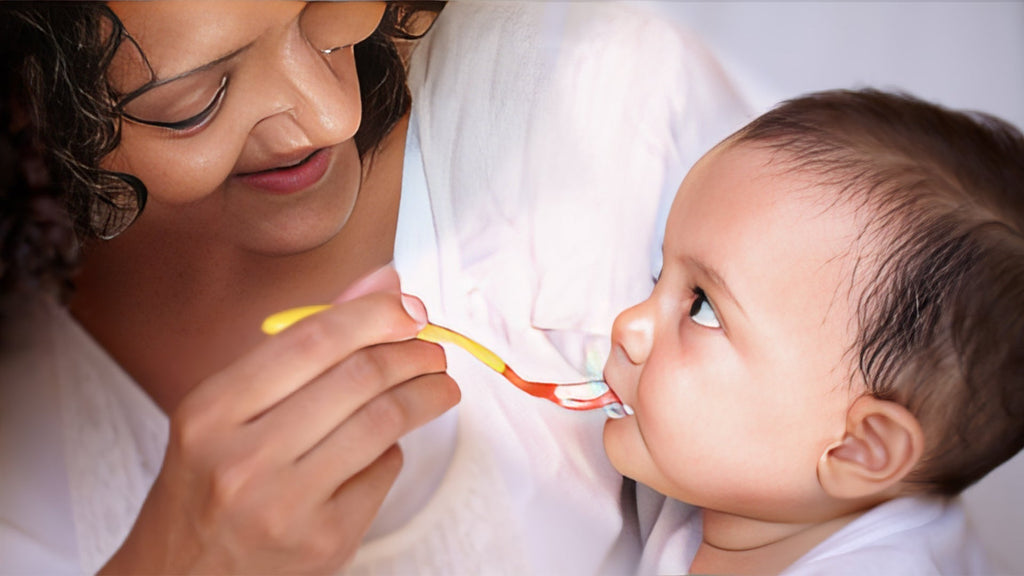
Comprehensive Baby Feeding Chart: Ages 0-12 Months
When you have a baby, your life suddenly fills with new responsibilities. There's so much to consider, from what to feed your baby to when to start introducing new foods. On top of that, you'll likely have elders, friends, and even strangers offering advice on what you should and shouldn't do. This flood of information can quickly become confusing, scary, and overwhelming.
But don't worry—you're not alone on this journey. In today's blog, we're here to help by sharing a comprehensive feeding chart for babies aged 0-12 months. As your little one grows, their nutritional needs change, and it's important to introduce the right foods at the right time. This guide is designed to simplify things, giving you clear, practical advice on what to feed your little one at each stage of their first year.
Understanding Your Baby's Feeding Needs
Before we get into the baby feeding chart, we must understand that every baby is unique. While this guide provides general recommendations, your baby's needs may vary. Always consult with your paediatrician to ensure you're on the right track.
Baby Feeding Chart: 0-12 Months

Below is a month-by-month breakdown of your baby’s feeding needs, including when to introduce new foods and how much to feed.
|
Age |
Type of Feeding |
Quantity per Feeding |
Frequency |
|
0-4 Months |
Breast milk or formula |
2-4 ounces |
Every 2-3 hours (8-12 times/day) |
|
4-6 Months |
Breast milk or formula, introduce solids |
4-6 ounces (milk) |
Every 3-4 hours (6-8 times/day) |
|
|
Small amounts of iron-fortified cereals |
1-2 tablespoons (solids) |
Once a day |
|
6-8 Months |
Breast milk or formula, pureed foods |
6-8 ounces (milk) |
Every 4-5 hours (5-6 times/day) |
|
|
Pureed fruits, vegetables, meats |
2-4 tablespoons (solids) |
2-3 times a day |
|
8-10 Months |
Breast milk or formula, mashed foods |
7-8 ounces (milk) |
Every 4-5 hours (4-5 times/day) |
|
|
Finger foods, soft fruits, and veggies |
3-5 tablespoons (solids) |
3 times a day |
|
10-12 Months |
Breast milk or formula, variety of solids |
7-8 ounces (milk) |
Every 4-5 hours (3-4 times/day) |
|
|
Soft-cooked family foods |
4-6 tablespoons (solids) |
3 times a day with snacks |
0-4 Months: Breast Milk or Formula Only
In the first four months, your baby's diet consists solely of breast milk or formula. This is the period when your baby is learning to latch, suck, and swallow. Breast milk provides all the essential nutrients your baby needs, including antibodies to fight infections. If you're formula-feeding, choose a formula that closely mimics the nutritional profile of breast milk.
It's important to feed on demand during this time, which means offering milk whenever your baby seems hungry. This could be as often as every 2-3 hours, including at night.
4-6 Months: Introduction to Solids
At around four to six months, your baby might start showing interest in solid foods. They might watch you eat, open their mouth for a spoon, or sit up with support. This is the time to start introducing solids but remember, breast milk or formula should still be the primary source of nutrition.
Start with iron-fortified single-grain cereals like rice or oatmeal mixed with breast milk or formula to a thin consistency. Use a small, shallow spoon to feed your baby and be patient as they get used to the new texture. As your baby gets more comfortable with solids, you can start offering small amounts of pureed fruits and vegetables.
A bamboo feeding bowl is a natural and safe option for feeding your baby. The silicone suction base securely grips flat surfaces to prevent mealtime spills.
6-8 Months: Exploring New Flavors
Your baby is ready to explore more flavours and textures between six to eight months. This is the perfect time to introduce pureed fruits, vegetables, and meats. You can include sweet potatoes, carrots, bananas, and avocados in their meal. When trying new foods, introduce them one at a time. Wait a few days before adding another food to check for any allergic reactions.
Breast milk or formula should still be offered, but now you can gradually increase the amount of solid food. Pureed foods should be soft and smooth, making it easy for your baby to swallow.
If you haven't already, you can introduce a glass feeding bottle at this stage. Glass bottles are a safe choice for your baby because they’re durable, easy to clean, and free from harmful chemicals like BPA.
8-10 Months: Finger Foods and Self-Feeding
By eight to ten months, your baby might be ready for more textured foods and even some finger foods. Soft fruits like bananas, steamed veggies like carrots, and small pieces of soft cheese are wonderful choices. Let your baby try feeding themselves with their little fingers—it’s a fun way for them to practice their motor skills and start building independence.
You can also start offering small amounts of family meals, as long as they are soft and not heavily seasoned. You can offer them Mash foods like potatoes on a fun looking wooden plate. Buy a Car Shaped Bamboo Feeding Plate, that is sturdy, and eco-friendly. This bamboo plate does not absorb bacteria or odours from your baby's meal.
10-12 Months: Eating with the Family
As your baby approaches their first birthday, they'll be eating a variety of solid foods and joining in on family meals. At this stage, they can handle more textures and flavours, so they offer a wide variety of soft-cooked family foods. Continue to provide breast milk or formula, but you'll notice they start drinking less as they eat more solids.
Introduce a balanced diet that includes fruits, vegetables, grains, and proteins. Encourage your baby to feed themselves with a spoon or fork but be prepared for some mess as they learn this new skill. Continue to monitor your baby for any food allergies and avoid foods that are choking hazards, like whole grapes or nuts.
Bonus Tip:
Make mealtimes enjoyable by sitting with your baby and eating together. This not only makes feeding fun but also encourages your baby to develop healthy eating habits by watching and imitating you.
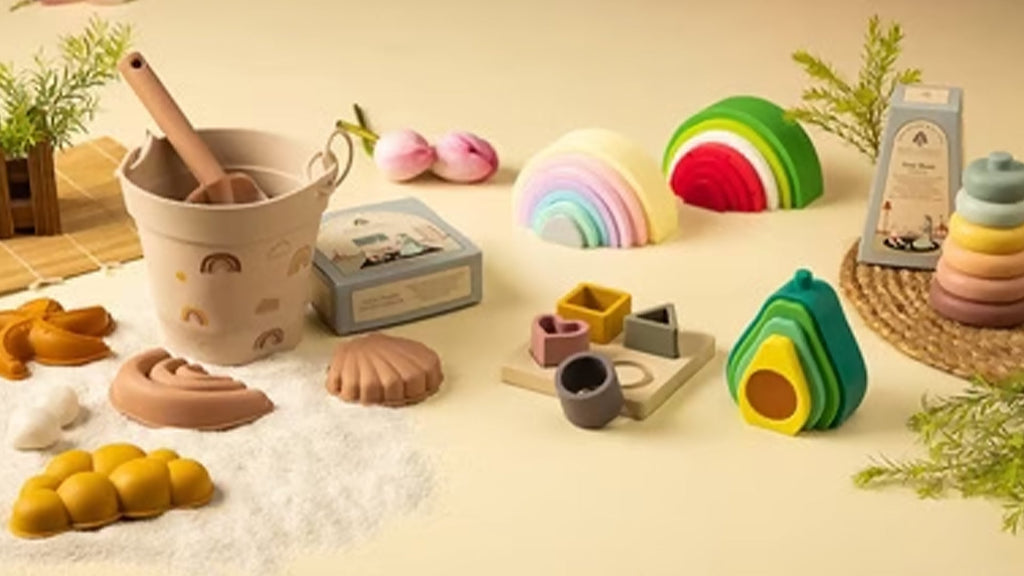
Types of Toys for Children by Age and Developmental Stage
Choosing the right toys for young children is more than just about fun—it's about supporting their growth and development. Toys play a crucial role in helping children learn about the world, develop new skills, and spark their imagination. However, with so many options available, it can be hard to know which toys are best for your child at each stage of their development. In this blog, we'll explore different types of toys that are ideal for young children based on their age and developmental stage.
Toys for Newborns to 6 Months: Exploring Senses
In the first six months of life, babies are just beginning to explore the world around them. At this stage, they are developing their senses, such as sight, sound, and touch. Toys that stimulate these senses are ideal.
Soft Toys:
Soft toys are perfect for newborns. They provide comfort and are safe for babies to touch and cuddle. Look for toys with different textures to help your baby explore the sense of touch. Soft toys like Mr. Monkey Soft Toy and the Lady Elph Soft Toy are loved by a lot of kids.
Baby Rattles:
Rattles are another great option for this age group. They are easy for little hands to grasp and shake, making them a fun way to explore sound. Baby rattles can also help develop motor skills as your baby learns to hold and move the rattle.
At this stage, it's important to choose toys that are safe, with no small parts that could be a choking hazard. Soft toys and rattles made from non-toxic materials are the best choices.
Toys for 6 to 12 Months: Developing Motor Skills
Between 6 and 12 months, babies become more active and start to develop their motor skills. They learn to sit up, crawl, and eventually take their first steps. Toys that encourage movement and coordination are ideal for this stage.
Spinning Lattu:
The spinning lattu is a traditional toy that can be a lot of fun for babies who are beginning to sit up. While your baby may not be able to spin the lattu on their own just yet, they will enjoy watching it spin. This toy helps develop hand-eye coordination as your baby learns to reach out and interact with it.
Stacking Toys:
Stacking toys, such as rings or blocks, are great for developing fine motor skills. Your baby will enjoy stacking the pieces and knocking them over, which also helps them understand cause and effect.
As babies become more mobile, they also enjoy toys that they can push or pull. These types of toys encourage walking and help develop balance and coordination.
Toys for 12 to 24 Months: Encouraging Problem Solving
From 12 to 24 months, toddlers are curious and eager to explore. They start to solve simple problems and understand how things work. Toys that encourage problem-solving and creativity are great for this age group.
Abacus Baby Wooden Toy:
The Abacus Baby Wooden Toy is a classic educational toy that helps toddlers learn to count and develop their fine motor skills. The bright colors and moving beads capture their attention, and as they slide the beads back and forth, they start to grasp the concept of counting.
Shape Sorters:
Shape sorters are another fantastic toy for this stage. They help toddlers learn about different shapes and sizes while also developing their problem-solving skills as they figure out which shape fits into which hole.
Toddlers also enjoy toys that let them mimic adult activities, like toy kitchens or tool sets. These toys allow them to engage in pretend play, which is important for developing imagination and social skills.
Toys for 2 to 3 Years: Building Imagination
As children enter their toddler years, their imagination begins to blossom. They enjoy playing pretend and exploring new roles. Toys that encourage imaginative play and creativity are perfect for this stage.
Soft Dolls or Animals:
Soft dolls or stuffed animals can become your child's favourite companions. They will enjoy playing house, caring for their dolls or animals, and even taking them on adventures. This type of play helps develop empathy and social skills.
Building Blocks:
Building blocks are a staple for this age group. They allow children to create structures and explore their creativity. Whether they are building towers, houses, or their own imaginative creations, blocks provide endless possibilities for play.
Art Supplies:
Simple art supplies, like crayons, colouring books, and playdough, are also great for toddlers. These tools help them express themselves creatively and develop fine motor skills.
Toys for 3 to 5 Years: Enhancing Learning and Coordination
By the time children are 3 to 5 years old, they are ready for toys that challenge their growing minds and bodies. At this stage, they enjoy activities that involve learning, coordination, and social interaction.
Puzzles:
Puzzles are fantastic for enhancing problem-solving skills and hand-eye coordination. Start with simple puzzles with large pieces and gradually move to more complex ones as your child's skills develop.
Sports Equipment:
Simple sports equipment, like a ball or a small basketball hoop, encourages physical activity and helps develop coordination. Playing sports also teaches children about teamwork and following rules.
Educational Games:
Educational games that teach letters, numbers, and shapes are also popular with this age group. These games make learning fun and prepare children for school.
Choosing the right toys for your child's age and developmental stage is a wonderful way to support their growth and learning journey. But remember, toys are just one part of the equation. Your involvement and interaction with your child during playtime are equally important. Playing together not only strengthens your bond but also enhances their learning experience. So, whether it's spinning a lattu or stacking blocks, make playtime a special time to connect, learn, and create lasting memories.
Bonus Tip:
Rotate your child's toys every few weeks. This keeps their interest alive and allows them to discover new ways to play with familiar items, further boosting their creativity and cognitive skills.
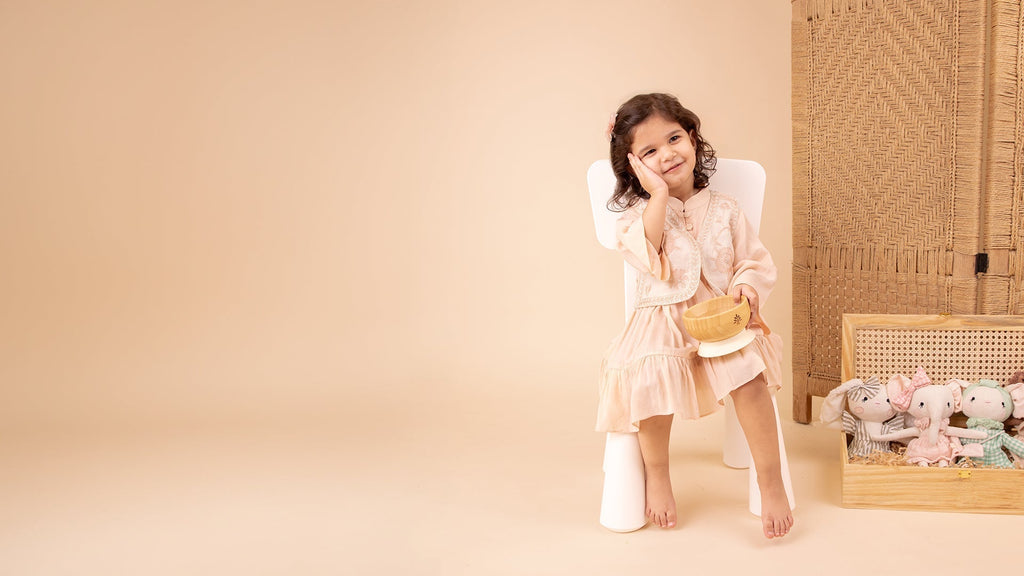
8 Must-Have Festive Clothing for Your Little One
Festive seasons are all about joy, celebration, and dressing up. And while you’re picking out your best outfits, don’t forget about your little one! Dressing up your baby in cute, festive clothing can add an extra sparkle to the celebrations. But with so many options out there, it can be hard to know where to start. That’s why we’ve put together a list of 8 must-have festive clothing items for your little one. These outfits are not only adorable but also comfortable, so your baby can enjoy the festivities as much as you do.
-
Checkered Frilled Baby Girl Dress
If there’s one dress that screams festive, it’s the Checkered Frilled Baby Girl Dress. This dress is perfect for special occasions, with its classic checkered pattern and delicate frills that add a touch of elegance. The soft fabric ensures your baby is comfortable throughout the day, while the frills give the dress a playful look. It’s a versatile piece that can be paired with cute accessories like a headband or tiny ballet flats to complete the festive look. -
Dress with Embroidered Jacket
For those cooler festive evenings, a Dress with an Embroidered Jacket is a perfect choice. The dress itself is simple and comfortable, but the embroidered jacket adds a layer of warmth and style. The intricate embroidery on the jacket gives it a traditional touch, making it suitable for cultural or religious celebrations. Plus, the jacket can be removed if it gets too warm, giving your baby girl the flexibility to move around comfortably. -
Hand Embroidered Gather Top with Underpants
This outfit is both adorable and practical, making it a must-have for your baby’s festive wardrobe. The Hand Embroidered Gather Top with Underpants is designed with delicate embroidery that adds a festive flair, while the gathered top provides a comfortable fit. The matching underpants make it easy to dress your baby without worrying about mismatched bottoms. -
Solid Dress and Embroidered Jacket Set
A Solid Dress and Embroidered Jacket Set is another excellent option for festive occasions. The solid-coloured dress is simple yet elegant, making it a versatile piece that can be worn on its own or with the embroidered jacket. The jacket adds a festive touch with its detailed embroidery, making the outfit suitable for more formal events. This set is also great for layering, so your baby stays warm and stylish no matter the weather. -
Baby Dungaree Set
Dungarees are timeless pieces of clothing that can be dressed up or down, making them a great addition to your baby’s festive wardrobe. This set comes with a cute inner t-shirt, making it an easy outfit to throw on when you’re in a hurry. Pair it with tiny sneakers or boots for a complete festive look for your baby boy that’s perfect for outdoor gatherings. -
Cotton Linen Romper Set
When it comes to festive clothing for babies, comfort is key, especially for babies. The Cotton Linen Romper Set offer just that, with its soft, breathable fabric that’s gentle on your baby’s skin. This set is perfect for warmer climates or indoor celebrations where you want your baby to stay cool and comfortable. The romper is easy to put on and take off, making diaper changes a breeze. Plus, the simple design allows you to accessorize with a festive hat or booties. -
Embroidered Shirt with Trouser Set
For a more traditional look, the Embroidered Shirt with Trouser Set is a fantastic choice. This outfit combines the classic style of a button-down shirt with the festive flair of embroidery. The trousers are designed to be comfortable yet stylish, allowing your baby to move around freely. This set is ideal for formal events or religious ceremonies where you want your little one to look their best. Pair it with tiny loafers to complete the sophisticated look. -
Checkered Shirt with Off-White Cotton Linen Romper Set
Last but not least, the Checkered Shirt with Off-White Cotton Linen Romper Set is a must-have for any festive occasion. The checkered shirt adds a fun and playful element, while the off-white romper keeps the look crisp and clean. The cotton linen fabric ensures that your baby stays comfortable, even during long celebrations. This outfit is perfect for daytime events and can be easily dressed up with a cute bow tie or down with a simple pair of sandals.
Tips for Choosing Festive Clothing for Your Baby

When selecting festive outfits for your little one, comfort should always be your top priority. Babies can get fussy if they’re uncomfortable, so choose soft fabrics that are gentle on their skin. It’s also a good idea to opt for outfits that are easy to put on and take off, as this will make diaper changes much easier during the festivities.
Another tip is to choose outfits that offer some flexibility. Many of the options mentioned above come with layers, like jackets or rompers, which can be added or removed depending on the weather. This way, your baby can stay comfortable whether you’re celebrating indoors or outside.
Lastly, don’t forget to have fun with your baby’s festive wardrobe! Festivals are a time for joy and celebration, and dressing up your little one is all part of the fun. Mix and match different pieces, add cute accessories, and take lots of photos to capture these precious moments. After all, these moments are ones you’ll treasure for years to come.

Benefits of Eucalyptus Oil in Baby Products: A Natural Ch...
Eucalyptus oil has been cherished for centuries for its healing and soothing properties. It’s a natural remedy often used in various health and wellness products. But did you know it can also be beneficial for your baby? In this blog, we’ll explore the benefits of eucalyptus oil for babies.
Eucalyptus oil infused products offer natural solutions and are gentle and safe for your little one.
What is Eucalyptus Oil?
Eucalyptus oil is extracted from the leaves of the eucalyptus tree. It is known for its refreshing scent and medicinal properties. This essential oil is often used in aromatherapy and is a popular ingredient in many natural health products. Eucalyptus oil can be a safe option for babies when used correctly and in appropriate amounts.
Instead of using the oil directly, it’s often more effective and safer to use products that incorporate eucalyptus as an ingredient. This ensures the oil is diluted to the right concentration, making it gentle enough for your baby’s delicate skin and sensitive system. Many baby products, such as vapor rubs and natural floor cleaners, include eucalyptus oil for its therapeutic benefits while ensuring it’s safe for everyday use. Let’s explore some of these benefits in more detail.
Benefits of Eucalyptus Oil in Baby Vapor Rubs
When your baby has a cold or feels congested, it can be really tough to see them uncomfortable. Baby vapour rubs containing eucalyptus oil can be a gentle and effective way to help relieve this discomfort.
-
Natural Decongestant
Eucalyptus oil acts as a natural decongestant. When applied to the chest or back, the soothing vapours can help to clear your baby’s nasal passages, making it easier for them to breathe. This is especially useful during colds or flu. -
Promotes Relaxation
The calming scent of eucalyptus oil can help your baby relax and sleep better. This is particularly helpful when your baby is restless due to illness. -
Safe for Sensitive Skin
Baby vapour rubs that contain eucalyptus oil are typically formulated to be gentle on sensitive skin. They are usually free from harsh chemicals, making them safer for your baby. -
Boosts Immunity
Eucalyptus oil is known for its antimicrobial properties. Products containing this oil can help protect your baby from germs and bacteria, boosting their immunity.
Eucalyptus Oil in Natural Floor Cleaners
When you have a baby, keeping the home clean is a top priority. Babies spend a lot of time on the floor, crawling and playing, so it’s important to ensure that the surfaces are free from harmful chemicals. This is where natural floor cleaners with eucalyptus oil come in.
-
Natural Disinfectant
Eucalyptus oil is a powerful disinfectant. It can effectively kill bacteria and viruses on surfaces when used in floor cleaners. This ensures that your baby is crawling on clean and safe floors. -
Safe for Babies
Unlike conventional floor cleaners that may contain harsh chemicals, natural floor cleaners with eucalyptus oil are free from toxins. This makes them safe for your baby to be around, reducing the risk of allergies or skin irritation. -
Pleasant Aroma
The fresh scent of eucalyptus oil leaves your home smelling clean and natural. It’s a great alternative to synthetic fragrances that can sometimes be overwhelming or irritating.
How to Use Eucalyptus Oil-Based Baby Products Safely?
While eucalyptus oil has many benefits, it’s important to use it safely, especially with babies.
-
Choose Baby-Specific Products
Always choose products that are specifically designed for babies. These products contain the right concentration of eucalyptus oil, ensuring that they are safe for your little one. -
Patch Test
Before using any new product on your baby, it’s a good idea to do a patch test. Apply a small amount of the product on a small area of your baby’s skin to check for reactions. -
Follow Instructions
Always follow the instructions on the product label. Use the recommended amount and avoid applying it too close to the baby’s face, especially around the eyes and nose. -
Consult Your Pediatrician
If you’re unsure about using eucalyptus oil products on your baby, consult your paediatrician. They can provide guidance based on your baby’s health and needs.
Additional Benefits of Eucalyptus Oil
Eucalyptus oil offers more than just respiratory and cleaning benefits. Here are a few more reasons to consider eucalyptus oil in your baby products:
-
Insect Repellent
Eucalyptus oil can act as a natural insect repellent. Products containing this oil can help keep mosquitoes and other insects away from your baby. -
Supports Respiratory Health
In addition to vapour rubs, eucalyptus oil can also be found in humidifiers and diffusers. These devices can help maintain healthy respiratory function by keeping the airways clear.
Eucalyptus oil is a natural, effective, and safe ingredient to include in baby products. Remember to always use these products as directed and consult your paediatrician if you have any concerns. Your baby deserves the best, and natural choices like eucalyptus oil are a step in the right direction.

A Day in My Life as a 12-Month-Old
Hi there! It’s me, your favorite 12-month-old influencer, I'm going to share a little bit about my typical day as a 12-month-old and a few growth milestones. Get ready to see all the cool things I do and the awesome products I use every day. Let’s dive in!
Morning Wake-Up Call
My day starts bright and early. I wake up with a stretch, a yawn, and a giggle, ready to start another amazing day. Mumma and Dadda might still be catching Z’s, but my cheerful babbling gets them up and smiling. First things first: diaper duty. Mommy uses the softest, most luxurious baby wipes – only the best for this little star!
Breakfast is next, and let me tell you, it’s an event. I sit in my highchair, ready to tackle my car-shaped feeding plate. It’s a mealtime must-have, with separate sections for all my favorite foods. Today’s menu? Banana bites and scrambled eggs. Yummy and nutritious!
Playtime Fun
After breakfast, it's playtime! I crawl over to my toy basket and pull out my favourite soft toy, Mr. Monkey. It's so cuddly and soft. We play on the floor, and I like to use my stacking toys and knock them over again. I'm getting pretty good at this!
From building little structures with pieces of toys, jumping over small hurdles in the backyard, or having fun during playtime with my parents, there is always something interesting for me like my wooden rabbit baby rattle & wooden car toy. My cognitive development has been phenomenal since birth, in particular my conducting abilities. It all starts with my ability to distinguish people or simple words that I have been instructed to obey.
Mommy says I'm reaching lots of infant milestones now. I’m also working on my walking skills. I hold onto the furniture and take wobbly steps, with Mommy cheering me on. Sometimes, we hold hands and walk around the house together – I feel like such a big kid!
Mid-Morning Nap
All that playing makes me sleepy, that reminds me, it's time for my morning nap. Mommy reads me a story, and then I snuggle up with Mr. Monkey in my crib. Naptime is important because it helps me grow and gives me energy for the rest of the day.
Lunchtime Delights
When I wake up, it's lunchtime. Mommy gives me a warm bath before lunch. Mommy uses the best baby body wash – it smells so nice and leaves my skin super soft. I love splashing and playing with my bath toys. My rubber ducky is my favourite.
After my bath, Mommy wraps me up in a big, fluffy towel and dries me off. Then, she applies baby body lotion on me to keep my skin soft. I love the feeling of being all clean and cosy. Today, I am wearing a very cute bodysuit.
For lunch, I sit in my highchair again, and today, I have some steamed vegetables, sweet potato, and a little bit of yoghurt. I'm getting better at using my spoon, but sometimes my hands are faster! I get food all over my face, and we both giggle.
Afternoon Adventures
As the morning turns to midday, I am still energetic, ready to jump and crawl around the house. Mommy reads me more stories, and I like to turn the pages. I can even point to some pictures when Mommy asks, "Where's the dog?" I love the stories with animals in them.
Then, it's time for another nap. I'm usually pretty tired by now, so I fall asleep quickly. When I wake up, we sometimes have visitors. Grandma and Grandpa come over, and they always bring me a new toy or book. I love spending time with them.
Dinner and Bedtime
Dinner time is another chance for me to practice eating different foods. Tonight, I have some dal khichdi. After dinner, we have a bit more playtime before it's time to get ready for bed.
Mommy changes me into my favorite blanket and gives me my bedtime bottle. We sit in the rocking chair, and she sings me a lullaby. I start to feel very sleepy. Mommy puts me in my crib with Mr. Monkey, and I snuggle up, ready for a good night's sleep.
Before going to bed, I follow my nighttime routine as my doctor suggested my newborn sleeping hours, because why not? I am no less than a celebrity! Every day is a new adventure, and I can't wait to see what tomorrow brings. Being a 12-month-old is exciting, and I'm learning so much every day.

Early Signs and What to Expect During Your Second Pregnancy
Expecting your second child brings a mix of excitement, anticipation, and perhaps a bit of apprehension. Each pregnancy is unique, and even though you have been through it before, being pregnant for a second time comes with its own set of experiences and challenges. Understanding what to expect during your second pregnancy can help you prepare better and manage your expectations.
Similarities and Differences Between First and Second Pregnancy
One of the first things you might notice is the difference between the first and second pregnancy. While some aspects may feel familiar, others might be quite different.
-
Physical Changes:
During your second pregnancy, your body might show signs earlier than it did the first time. This is because your abdominal muscles have already been stretched, making it easier for your baby bump to become noticeable sooner. -
Fatigue:
You might feel more tired this time around. Juggling a toddler or older child, along with the demands of pregnancy, can be exhausting. Make sure to rest as much as possible and ask for help when needed.
Common Symptoms You Might Notice Again in Your Second Pregnancy
The second pregnancy symptoms might be similar to what you experienced the first time, but there could also be new symptoms or variations in intensity.
-
Morning Sickness:
Some women experience less morning sickness during their 2nd pregnancy, while others find it just as intense or even worse. -
Back Pain:
Back pain might be more pronounced during your second pregnancy due to the added strain of caring for your first child. -
Braxton Hicks Contractions:
These "practice" contractions may start earlier and be more noticeable. -
Fatigue:
Feeling tired is common again, and it might be more intense if you are chasing a toddler while pregnant. -
Showing Earlier:
Many women notice that their baby bump appears sooner in the second pregnancy, as the abdominal muscles are already stretched. -
Stronger Baby Movements:
You might feel the baby kick earlier and more clearly because you know what to look for and your body is more tuned in. -
Round Ligament Pain:
As your uterus grows faster, you may feel sharper stretching sensations on the sides of your belly. -
Frequent Urination:
This may come back, sometimes even earlier, as the uterus grows and presses on the bladder.
Recognizing Second Pregnancy Symptoms Early On

Early Symptoms of Second Pregnancy
Just like the first time, there are early symptoms of a second pregnancy that you may notice even before you miss your period. These can include:
- Fatigue: Feeling unusually tired is a common sign.
- Nausea: Some women experience nausea very early on.
- Breast Tenderness: Your breasts might feel sore or tender.
- Frequent Urination: The need to urinate more often can be an early sign.
Symptoms of Second Pregnancy in the First Week
During the first week, the symptoms of a second pregnancy in the first week are often subtle but can include mild cramping and spotting, known as implantation bleeding. Some women also report feeling more emotional or having mood swings due to hormonal changes.
Tips to Prepare for a Second Pregnancy
Getting ready for a second pregnancy can feel different from the first time. You may already know what to expect, but now you also have a little one to care for. Here are some simple tips to help you prepare physically, emotionally, and mentally.
Take care of your health - Before trying for a second baby, visit your doctor for a checkup. Make sure you are getting the right nutrients, especially folic acid, iron, and calcium. Eating healthy and staying active will also help your body prepare for pregnancy.
Rest when you can - It might be harder to find time to rest with a child at home but try to take short naps or breaks whenever possible. Your body needs energy to support another pregnancy.
Talk to your first child - Depending on their age, gently prepare your first child for the idea of a new baby. This can help them feel involved and excited rather than left out.
Plan for support - Juggling a pregnancy while caring for another child can be tiring. Talk to your partner, family, or close friends about how they can help once the baby arrives.
Managing Your Second Pregnancy
With the experience from your first pregnancy, you might feel more confident this time. However, it's essential to take care of yourself and manage your pregnancy carefully.
-
Prenatal Care:
Regular check-ups with your healthcare provider are crucial. Even though you have been through it before, each pregnancy is different, and monitoring your health and your baby's development is important. -
Nutrition:
Maintain a balanced diet rich in essential nutrients. Your body's nutritional needs might be higher during your second pregnancy. -
Exercise:
Staying active can help manage weight, reduce stress, and improve overall health. Activities like walking, swimming, and prenatal yoga are great options.
Every pregnancy is unique—so is weight gain! Find out the ideal range for you with our Weight Gain Calculator.
Preparing Your First Child for a New Sibling
One significant difference between your first and second pregnancy is the presence of your older child. Preparing them for the arrival of a new sibling can help ease the transition.
-
Involve Them:
Include your child in preparations, like setting up the baby's room or choosing baby clothes. -
Discuss Changes:
Talk to your child about the changes to expect and how they can help care for the new baby. -
Quality Time:
Spend quality time with your first child, ensuring they feel loved and secure.
Emotional Changes
Emotional changes during your second pregnancy can be different as well. You might feel more relaxed knowing what to expect, but you could also feel overwhelmed managing a toddler and being pregnant.
-
Mixed Feelings:
It's normal to have mixed feelings about your second pregnancy. Joy, anxiety, and even guilt about how the new baby will impact your first child are common. -
Support System:
Lean on your support system, including your partner, family, and friends. Joining a support group for second-time moms can also be helpful.
Practical Preparations
Preparing for your second baby involves practical considerations, such as:
-
Baby Gear:
Assess what baby products you already have and what you need to purchase or replace. -
Childcare Plans:
Plan for childcare for your first child during labour and delivery. -
Financial Planning:
Review your financial plans to accommodate the new addition to your family.
Conclusion
Remember, every pregnancy is unique, and it's essential to take care of yourself and seek support when needed. With the right preparation and mindset, you can enjoy this special time and look forward to welcoming your new baby into your family.
Excited to meet your baby? Find out your estimated due date with our easy-to-use calculator!

Understanding Newborn Reflexes: What Every Parent Should ...
Becoming a parent brings immense joy and a host of new responsibilities. One of the most fascinating aspects of newborn development is their innate ability to perform certain actions without any prior learning or experience. These involuntary movements, known as newborn reflexes, are crucial indicators of a baby's neurological health and development. Understanding these infant reflexes can help parents better care for their babies and recognize normal behaviors.
What Are Newborn Reflexes?
Newborn reflexes are automatic movements or actions that a baby exhibits in response to certain stimuli. These reflexes are present from birth and gradually fade as the baby grows older and gains voluntary control over their muscles. Pediatricians routinely assess newborn reflexes during check-ups to ensure that the baby's nervous system is developing properly.
A List of Newborn Reflexes Every Parent Should Know About
Here is a comprehensive list of newborn reflexes every parent should be familiar with:

-
Rooting Reflex:
When you gently stroke your baby's cheek, they will turn their head toward the touch and open their mouth. This newborn rooting reflex helps the baby find the nipple or bottle to start feeding. -
Sucking Reflex:
When the roof of your baby's mouth is touched, they will start to suck. This reflex is essential for feeding and is present from birth. -
Moro Reflex (Startle Reflex):
This occurs when a baby is startled by a loud noise or sudden movement. The baby will throw their arms out, open their hands, and then bring their arms back to their body, often crying afterward. This infant's startle reflex is a normal part of development. -
Grasp Reflex:
When you place your finger in your baby's palm, they will grasp it tightly. The grasp reflex in newborns is a strong reflex and indicates good muscle tone and strength. -
Babinski Reflex:
When you gently stroke the sole of a baby's foot, you'll see the big toe bending back toward the top of the foot, while the other toes fan out in a delightful way. This reflex is a normal finding in infants but disappears as the nervous system matures. -
Stepping Reflex:
If you hold your baby upright with their feet touching a solid surface, they will make stepping motions as if they are trying to walk. This reflex usually disappears around two months of age. -
Tonic Neck Reflex (Fencing Reflex):
When a baby's head is turned to one side, the arm on that side will stretch out, and the opposite arm will bend at the elbow. This reflex resembles the position of a fencer and is a normal part of development. -
Plantar Grasp Reflex:
Similar to the hand grasp reflex, this occurs when you touch the sole of the baby's foot, causing their toes to curl. This reflex also fades as the baby grows older.
Importance of Assessing Newborn Reflexes
Assessing newborn reflexes is a critical part of pediatric check-ups. These reflexes provide valuable information about the development and function of the nervous system. If a reflex is absent or abnormal, it may indicate a neurological problem that requires further investigation. Regular assessment ensures that any potential issues are identified and addressed early.
How Long Do Newborn Reflexes Last?
Most newborn reflexes are temporary and disappear as the baby's brain matures and they gain voluntary control over their movements. Here's a general timeline for when some of these reflexes fade:
- Rooting Reflex: Disappears in four months
- Sucking Reflex: Becomes voluntary around four months
- Moro Reflex: Fades by 5-6 months
- Grasp Reflex: Disappears by 5-6 months
- Babinski Reflex: Disappears in 12-24 months
- Stepping Reflex: Fades by two months
- Tonic Neck Reflex: Disappears by 5-7 months
- Plantar Grasp Reflex: Disappears by 9-12 months
Recognizing Normal and Abnormal Reflexes
While most reflexes are present in all healthy newborns, it's important to recognize what is normal and what might be a cause for concern. For instance, the absence of the moro reflex in newborn or a weak grasp reflex in newborn could indicate an issue that needs medical attention. Always consult your pediatrician if you have concerns about your baby's reflexes or overall development.
Encouraging Healthy Reflex Development
While newborn reflexes are involuntary, you can still support your baby's development in several ways:
-
Tummy Time:
Placing your baby on their tummy while they are awake helps strengthen their neck, shoulder, and arm muscles, which supports overall motor development. -
Gentle Handling:
Always handle your baby gently and support their head and neck, especially in the early months when their muscles are still developing. -
Interactive Play:
Engage in activities that stimulate your baby's senses and encourage movement, such as gently touching their hands and feet or offering colorful, textured toys.
Monitoring Your Baby's Development
As your baby grows, their reflexes will gradually be replaced by voluntary movements. Keep track of their milestones and report any concerns to your pediatrician. Regular check-ups are essential for monitoring your baby's growth and ensuring they are meeting developmental milestones.
Read More: Baby's First Month: Growth and Milestones Achieved
Understanding newborn reflexes is an essential part of early parenthood. These involuntary movements provide insight into your baby's neurological health and development. By familiarizing yourself with the list of newborn reflexes and knowing what to expect, you can better care for your baby and ensure they are on a healthy developmental path. Always consult with your pediatrician if you have any concerns about your baby's reflexes or overall growth. With the right knowledge and support, you can confidently navigate the early stages of your baby's life.
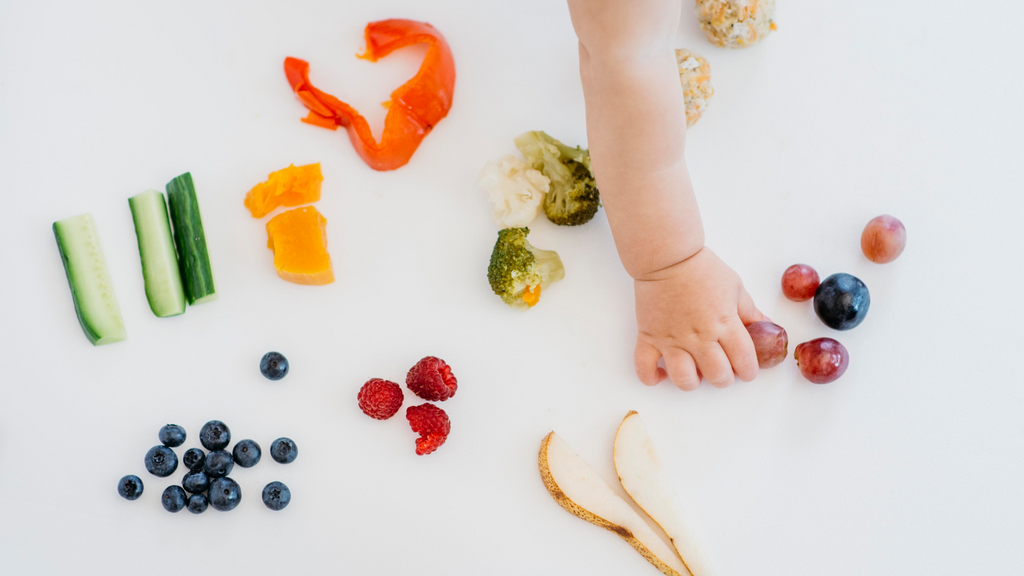
Purees vs. Finger Foods: Which Is Best for Your Baby?
Starting solids with your baby is a major milestone that signifies the beginning of a new phase in their growth and development. Parents often find themselves debating between purees and finger foods when deciding the best approach to start their baby with solid foods. Each method has its own advantages and considerations, and understanding these can help you make an informed decision that best suits your baby's needs. This comprehensive guide explores the differences between purees and finger foods and helps you decide which is best for your baby.
Purees: A Traditional Approach
Puree food is the traditional method of introducing solids to babies. It involves blending or mashing fruits, vegetables, and other foods into a smooth consistency that is easy for babies to swallow and digest.
Advantages of Purees:
-
Easier to Swallow:
Puree food is smooth and easy for babies to swallow, which reduces the risk of choking. This is particularly important for younger babies who are just learning to eat solid foods. -
Controlled Nutrient Intake:
Purees allow parents to control the ingredients and ensure that their baby is getting a balanced diet. You can easily mix and match different fruits, vegetables, and grains to provide a variety of nutrients. -
Gradual Texture Introduction:
Starting with purees allows babies to gradually get used to different textures. You can gradually increase the thickness and lumpiness of the purees as your baby becomes more accustomed to solid foods.
Considerations for Purees:
-
Limited Exposure to Textures:
Since purees are smooth, babies may not get used to different textures early on, which can delay the development of chewing skills. -
More Preparation Time:
Making homemade purees can be time-consuming, and parents need to ensure they are stored and handled properly to maintain nutritional value.
Finger Foods: Encouraging Independence
Finger foods are small pieces of food that babies can pick up and eat on their own. This method is often associated with baby-led weaning, where babies are encouraged to self-feed from the start.
Advantages of Finger Foods:
-
Promotes Independence:
Finger food encourages babies to self-feed, which can help develop fine motor skills and hand-eye coordination. -
Exposure to Textures:
Introducing baby finger foods early on exposes babies to a variety of textures, which can help them become more comfortable with different types of food. -
Family Mealtime Participation:
With finger foods, babies can join the family at mealtime and eat similar foods, making them feel included and promoting social interaction.
Considerations for Finger Foods:
-
Choking Risk:
There is a higher risk of choking with finger foods, so it's important to choose appropriate foods and supervise your baby while they eat. -
Messy Eating:
Finger foods can be messy, as babies are learning to feed themselves and may drop or smear food around.
Introducing Solids to Baby
Many parents find that a combination of purees and finger foods works best. This approach allows babies to enjoy the benefits of both methods and can help ease the transition from purees to more solid foods.
Starting with Purees:
- Begin with single-ingredient purees, such as mashed bananas, steamed and blended carrots, or pureed peas. These foods are gentle on your baby's digestive system and provide essential nutrients.
- Gradually introduce more complex combinations, like apple and sweet potato puree or rice and lentil porridge, to ensure a balanced diet.
Introducing Finger Foods:
- Once your baby is comfortable with purees, start offering small, soft pieces of food that they can pick up and eat on their own. Some great baby finger foods include small pieces of steamed vegetables, soft fruits, and well-cooked pasta.
- Monitor your baby closely to ensure they are chewing properly and not choking on the food.
Baby Led Weaning: Encouraging Self-Feeding
Baby-led weaning is an approach that skips purees altogether and starts with finger foods. This method allows babies to explore and enjoy a variety of textures and tastes right from the start.
Advantages of Baby-Led Weaning
Natural Progression:
Babies learn to chew and swallow at their own pace, which can help improve their eating skills and reduce fussiness with food.
Family Meals:
Babies eat the same foods as the rest of the family, which promotes a healthy eating environment and makes meal preparation easier.
Considerations for Baby-Led Weaning:
Choking Hazard:
As with any method involving solid pieces of food, there is a risk of choking. Always choose age-appropriate foods and supervise your baby while they eat.
Nutritional Balance:
Ensuring your baby gets all the necessary nutrients can be challenging with baby-led weaning. It's important to offer a wide variety of foods to meet their nutritional needs.
To learn more about baby-led weaning you can read this: https://www.babyforest.in/blogs/thoughts-and-ideas/baby-led-weaning
Finally; Purees or Finger Foods?
There is no one-size-fits-all answer when it comes to choosing between purees and finger foods. Both methods have their benefits and challenges, and the best approach depends on your baby's needs and your family's lifestyle. Many parents find success with a combination of both methods, starting with purees and gradually introducing finger foods as their baby becomes more comfortable with solid foods. Whichever method you choose, the most important thing is to ensure your baby is getting a balanced diet and enjoying their mealtime experiences.

Breastfeeding Twins: A Comprehensive Guide for New Moms
Welcoming twins into your life is a joyous occasion, but it can also be overwhelming, especially when it comes to breastfeeding. Breastfeeding twins presents unique challenges and requires special techniques, but with the right information and support, you can successfully nourish your babies. This comprehensive guide will cover everything you need to know about nursing twins, from twin breastfeeding positions to creating a twin-feeding schedule.
Benefits of Breastfeeding Twins
Breastfeeding offers numerous benefits for both mothers and babies. For twins, it provides the essential nutrients needed for growth and development while also promoting a strong immune system. For mothers, breastfeeding helps in postpartum recovery and strengthens the bond with each baby. Additionally, it is economical and convenient, eliminating the need for formula and bottle preparations.
Getting Started with Breastfeeding Twins
How to breastfeed twins can be daunting at first, but with some preparation and patience, you can establish a successful breastfeeding routine. Here are some initial steps to help you get started:
-
Seek Early Support
Contact a lactation consultant or join a support group for mothers of twins. Professional guidance can be invaluable in addressing specific concerns related to breastfeeding twins. -
Create a Comfortable Feeding Area
Set up a dedicated space for breastfeeding with comfortable seating, pillows for support, and easy access to water, snacks, and entertainment.
-
Practice Makes Perfect
Initially, you might find it challenging to position both babies correctly. Practice different twin breastfeeding positions until you find what works best for you and your babies.
Twin Breastfeeding Positions
Finding the right twin breastfeeding positions is crucial for comfort and efficiency. Here are some popular positions to consider:
-
Football Hold
This position involves holding each baby under your arm, with their legs pointing towards your back. It provides excellent support and allows you to control their heads easily. -
Cradle Hold
In this position, each baby is held across your lap, with their heads resting in the crook of your arms. This is a natural and comfortable position for many mothers. -
Double Clutch
Similar to the football hold but with both babies positioned on the same side. This can be useful if you have limited space or need to free up one hand. -
Upright Hold
Suitable for older babies who can support their heads. Both babies sit on your lap facing you, which can be less tiring for your arms.
Experiment with these positions to determine what feels most comfortable and effective for you and your twins.
Establishing a Twins Feeding Schedule
Creating a consistent twin feeding schedule is essential for managing your time and ensuring both babies are well-fed. Here are some tips to help you establish a schedule:
Synchronize Feedings
Try to feed both babies at the same time. This can save you a lot of time and energy compared to feeding them separately.
Track Feedings
Use a notebook or an app to record feeding times, durations, and which breast each baby is nursed from. This helps ensure both babies receive equal feeding time and allows you to monitor their intake.
Be Flexible
While a schedule is helpful, it's important to remain flexible. Babies' needs can change frequently, especially during growth spurts. Adapt your schedule as needed.
Managing Milk Supply
A common concern for mothers of twins is whether they will produce enough milk. Here are some tips to boost and maintain your milk supply:
Frequent Nursing:
The more you nurse, the more milk your body will produce. Aim to feed your babies every 2-3 hours or on demand.
Stay Hydrated and Nourished:
Drink plenty of water and eat a balanced diet rich in nutrients to support milk production.
Pumping:
Consider pumping between feedings to stimulate milk production and build a supply of expressed milk.
Overcoming Challenges
Breastfeeding twins can present unique challenges, but with patience and perseverance, you can overcome them. Here are some common issues and how to address them:
Latch Issues:
If one or both babies have difficulty latching, seek help from a lactation consultant. They can provide techniques to improve latch and ensure effective feeding.
Sore Nipples:
Use lanolin cream or nipple shields to soothe sore nipples. Ensure proper latch to minimize discomfort.
Fatigue:
Caring for twins is exhausting. Rest whenever possible, and don't hesitate to ask for help from family and friends.
Remember, every mother and baby pair is unique, so find what works best for you and seek support when needed. With the right approach and mindset, you can make nursing twins a positive and fulfilling experience.

Must-Have Baby Essentials for a Safe and Comfortable Monsoon
The monsoon season brings with it a refreshing break from the heat, but it also introduces new challenges for parents of young babies. High humidity, increased moisture, and cooler temperatures can affect your baby's comfort and health. Preparing with the right baby essentials can make a big difference in ensuring your little one stays safe and comfortable during the rainy season. Here's a detailed guide on must-have baby products for a safe and comfortable monsoon.

Essential Baby Products for this Monsoon
Talc-Free Baby Powder
During the monsoon, the increased humidity can cause your baby to sweat more, which can lead to heat rashes and discomfort. A talc-free baby powder is essential to keep your baby's skin dry and prevent rashes. The Dulaar Pyar Baby Powder is made from natural ingredients like corn starch and oats kernel, which are gentle on your baby's delicate skin. This talc-free powder helps absorb excess moisture and reduce friction, keeping your baby's skin smooth and dry throughout the humid season.

Baby Vapour Rub
Monsoon weather often brings cooler temperatures and can exacerbate colds and respiratory issues in babies. A baby vapour rub is a must-have during this monsoon. The Komal Shwaas Baby Vapour Rub is formulated for infants and contains natural ingredients like eucalyptus and lavender oils. These ingredients help relieve nasal congestion, making breathing comfortably easier for your baby. Apply a small amount on your baby's chest, back, and soles of their feet before bedtime to help them sleep better during cold and damp nights.

Baby Rash Healing Cream
Wet weather and frequent diaper use can increase the likelihood of diaper rashes. A baby rash healing cream must be on hand during monsoon. Baby Forest’s Komal Kawach Diaper Rash Healing Cream contains Kusha, Harachampaka Madanah, and Geranium oil that creates a protective layer and keeps the baby’s skin soft, dry and supple. It also includes soothing ingredients like Aloe Leaf Juice and Jojoba oil. Regularly applying a rash cream can prevent rashes from developing and ensure that any existing rashes heal quickly.

Natural Floor and Baby Toy & Surface Cleaner
Monsoon season often brings mud and dirt indoors, increasing the risk of germs and bacteria that can affect your baby's health. A natural floor cleaner and, a baby toy & surface cleaner are vital for keeping your home clean and safe for your baby. The Swaksh Bhoomi Natural Floor Cleaner is made from natural, non-toxic ingredients, ensuring your baby is not exposed to harsh chemicals. This cleaner disinfects floors and surfaces, providing a hygienic environment for your baby to crawl and play safely. Similarly, the Swaksh Khilone Baby Toy & Surface Cleaner is designed to keep toys and surfaces free from germs, using non-toxic ingredients. Regular use of these cleaners helps maintain hygiene and reduces the risk of infections, especially during the monsoon when mold and mildew can thrive.

Pashmina Baby Blanket
Keeping your baby warm and cozy during the cooler monsoon months is important. A Pashmina baby blanket is an excellent choice for this purpose. Our Kashmiri Pashmina Baby Blanket is made from incredibly soft pashmina wool, which is lightweight and provides excellent insulation. These blankets are perfect for wrapping your baby during naps or bedtime, offering warmth without overheating. Pashmina blankets are also breathable, preventing your baby from getting too hot and ensuring they stay comfortable. Its luxurious feel makes them a comforting and soothing choice for your baby.

Baby Swaddles
Swaddling helps babies feel secure and improves their sleep quality, which is especially beneficial during the monsoon when the weather can be unpredictable. Baby swaddles made from soft, breathable fabrics like cotton or muslin are ideal. The Komal Aavran Baby Swaddle is made from soft, breathable fabric that helps regulate your baby's body temperature, preventing overheating while keeping them snug. Swaddling can also reduce the startle reflex, which often wakes babies up.

Baby Towel
When it comes to keeping your baby dry and comfortable after baths, the Somya Aanchal Baby Towel is an excellent choice. This towel offers exceptional absorbency and softness, made with a blend of 60% zero-twist cotton and 40% bamboo. The hooded design adds a touch of cuteness and ensures your baby's head stays warm, which is especially important during the cooler monsoon months. Generously sized for ample coverage, this towel is gentle on your baby's delicate skin and provides the ultimate comfort after bath time.

Additional Tips for a Safe and Comfortable Monsoon
-
Maintain a Clean Environment
Regularly clean your baby's room and play areas to prevent mold and mildew, which thrive in humid conditions. -
Dress Appropriately
Dress your baby in lightweight, breathable clothing to prevent overheating. Layering is a good strategy, as you can easily add or remove layers based on the temperature. -
Monitor Humidity Levels
Use a dehumidifier to control indoor humidity levels. High humidity can cause discomfort and promote the growth of mold and bacteria. -
Stay Dry
Ensure your baby stays dry by promptly changing clothes and diapers. Wetness can cause skin irritation and rashes.
Preparing for the monsoon season with the right baby products can significantly improve your baby's safety and comfort. Each item plays a crucial role in addressing the unique challenges of the rainy season, from talc-free baby powder to keep their skin dry to a pashmina baby blanket for warmth. Incorporating these products into your daily routine will help you easily navigate the monsoon, keeping your baby happy, healthy, and comfortable. Remember, the key to a stress-free monsoon is preparing and choosing high-quality products catering to your baby's needs.

Buying a Baby Towel? Here’s what you need to know!
Choosing the right baby towel is essential for your baby's comfort and hygiene. With so many options available, it can be overwhelming to decide which towel is best for your little one. In this guide, we'll explore the key factors to consider before purchasing a baby bath towel, ensuring you make an informed decision that keeps your baby warm, dry, and comfortable.
Factors to Consider While Purchasing a Baby Bath Towel:
Soft and Comfortable
One of the most important features to look for in a baby towel is its softness. A soft bath towel for a baby is gentle on your baby's delicate skin, reducing the risk of irritation and discomfort. Babies have much more sensitive skin than adults, so using a towel that is soft and plush can make bath time a pleasant experience.
When shopping for a baby bath towel, consider the material. Towels made from natural fibres like cotton are usually softer and more comfortable. A cotton towel for a baby is an excellent choice because it is not only soft but also breathable, ensuring your baby's skin stays healthy and free from rashes.
Highly Absorbent
The primary function of a towel is to dry, so it's crucial to choose a baby towel that is highly absorbent. After a bath, you want to be able to dry your baby quickly and efficiently to prevent them from getting cold. Look for towels that are thick and have a high absorbency rate, as these will soak up moisture effectively.
Materials like cotton and bamboo are known for their excellent absorbency. A blend of these materials can offer superior performance. For instance, our baby towel combines 60% zero-twist cotton, and 40% bamboo providing exceptional absorbency, making it ideal for drying your baby quickly after a bath.
Eco-Friendly
In today's world, making eco-friendly choices is more important than ever. When selecting a baby bath towel, consider the environmental impact of the product. Towels made from organic cotton or bamboo are great eco-friendly options. These materials are sustainable and biodegradable, reducing your environmental footprint.
Organic cotton is grown without harmful pesticides and chemicals, making it safer for your baby and better for the environment. Bamboo is another excellent choice as it grows quickly without the need for fertilizers or pesticides. Choosing an eco-friendly cotton towel for your baby not only benefits the planet but also ensures that your baby's skin is not exposed to harmful substances.
Durable
Durability is another crucial factor to consider when buying a baby towel. Babies can be messy, and their towels will need frequent washing. A durable towel will withstand repeated laundering without losing its softness or absorbency.
High-quality towels made from strong fibers like cotton and bamboo are more likely to remain in good condition over time. Investing in a durable soft bath towel for your baby means you won't have to replace it frequently, saving you money in the long run.
Hooded Towel for Baby
A hooded towel for the baby adds an extra touch of practicality and cuteness to bath time. The hood helps keep your baby's head warm after a bath, which is especially important for young babies who can lose heat quickly. A hooded towel also makes it easier to wrap and dry your baby, ensuring they stay snug and comfortable.
Hooded towels come in various designs and sizes, so you can choose one that best fits your baby's needs. The hooded design not only looks adorable but also provides additional warmth and coverage, making it a must-have item for bath time.
Why Choose Somya Aanchal Baby Towel?
Choosing the Somya Aanchal Baby Towel ensures you're providing your baby with the best in comfort, absorbency, and eco-friendliness. This towel stands out because it combines the softness of 60% zero-twist cotton with the sustainability of 40% bamboo, making it exceptionally gentle on your baby's delicate skin. The generous size offers ample coverage, keeping your baby warm and cosy after bath time. The hooded design not only adds an adorable touch but also provides extra warmth for your baby's head. Additionally, the high absorbency of the Somya Aanchal Baby Towel ensures quick drying, making it an essential item for every new parent who values quality and practicality.


A Parent's Guide to Baby Ear Piercing: Here’s What You Ne...
Baby ear piercing is a common practice in many cultures around the world, often steeped in tradition and personal significance. Whether you are considering ear piercing for your baby for cultural, aesthetic, or personal reasons, it's important to understand the process, the benefits, and the necessary aftercare. This guide will provide you with everything you need to know about baby ear piercing, ensuring you make an informed and safe decision for your little one.
Cultural Significance of Baby Ear Piercing
In many cultures, ear piercing for babies is more than just a fashion statement; it holds deep cultural and religious significance. One such tradition is the Karnavedha Sanskar, an ancient Indian ritual where a baby's ears are pierced. The Karnavedha ceremony is one of the 16 sacraments, or 'samskaras,' in Hindu culture, symbolizing the child's ability to hear and absorb knowledge.
Indian baby ear piercing is often performed during a special ear-piercing ceremony where family and friends gather to celebrate. This event is seen as a rite of passage and is usually conducted by a priest or a trained professional. The Karnavedha sanskar is believed to have several spiritual and health benefits, including the stimulation of vital energy points and the improvement of cognitive functions.
When to Pierce Your Baby's Ears
The ideal time to pierce a baby's ears varies among cultures and personal preferences. Some parents choose to do it when their baby is just a few months old, while others may wait until the child is older. There are several factors to consider when deciding the best time for a baby ear piercing:
-
Age
Many pediatricians recommend waiting until the baby has received their first set of vaccinations, usually around 2-4 months old. At this age, the baby's immune system is more developed, reducing the risk of infection. -
Pain Tolerance
Younger babies may tolerate the discomfort of ear piercing better than older children, who might remember the pain and be more resistant to the procedure. -
Healing Process
Babies tend to heal faster than older children and adults, making the recovery period shorter and potentially less complicated.
The Ear-Piercing Procedure
Knowing what to expect during the ear-piercing ceremony can help you prepare and reduce anxiety for both you and your baby. Here's a step-by-step overview of the process:
-
Preparation
Clean the baby's earlobes with an antiseptic solution. The professional will mark the exact spots where the earrings will be placed. -
Piercing
Using a sterilized piercing instrument or needle, the professional will quickly pierce the earlobes. The use of a quick and efficient method helps minimize discomfort. -
Aftercare Instructions
The professional will provide detailed aftercare instructions to ensure proper healing and prevent infection. Follow these instructions carefully for the best results.
Benefits of Baby Ear Piercing
There are several perceived ear-piercing benefits for babies, especially within cultural contexts:
-
Cultural Identity
For many families, piercing a baby's ears is a way to connect with cultural traditions and instill a sense of identity from a young age. -
Health Beliefs
In some traditions, ear piercing is believed to have health benefits, such as improving eyesight and enhancing brain development. The Karnavedha sanskar, for example, is thought to stimulate important energy points in the body. -
Aesthetic Appeal
Many parents choose to pierce their baby's ears for aesthetic reasons, appreciating the look of small earrings on their child.
Aftercare Tips
Proper aftercare is essential to ensure that your baby's ears heal properly and to avoid complications. Here are some key aftercare tips:
Cleaning:
Clean the pierced area twice daily with an antiseptic solution or saline water. Avoid using alcohol or hydrogen peroxide, as these can dry out the skin and delay healing.
Avoid Touching:
Try to minimize touching or twisting the earrings to prevent irritation and introduce bacteria. Always wash your hands before handling the earrings.
Monitor for Infections:
Keep an eye out for signs of infection, such as redness, swelling, discharge, or increased tenderness. If you notice any of these symptoms, contact your pediatrician immediately.
Earring Material:
Use hypoallergenic earrings, preferably made of surgical steel, gold, or platinum, to reduce the risk of allergic reactions.
Baby ear piercing is a significant decision that involves careful consideration of cultural practices, health benefits, and personal preferences. Whether you're participating in a traditional Karnavedha ceremony or simply choosing to pierce your baby's ears for aesthetic reasons, it's essential to understand the process and follow proper aftercare instructions. By selecting a qualified professional and adhering to recommended practices, you can ensure a safe and positive experience for your little one. Celebrate this special milestone with confidence, knowing that you've made an informed and thoughtful choice for your baby's well-being.

Baby Milestones and Development of a 2-Month-Old
Welcoming a baby into your life is a joyous occasion filled with wonder and excitement. As your little one grows, you'll notice many changes and developments. At two months old, your baby is beginning to show more of their personality and reaching several key milestones. Understanding these 2-month-old milestones will help you support your baby's growth and development.
2-Month-Old Baby’s Physical Development
One of the most noticeable changes at two months old is physical development. Your baby is growing rapidly, and you might see significant changes in their appearance and abilities.
-
Weight and Length
By two months, many babies have gained about 1-2 pounds since birth and grown about 1-2 inches in length. Regular check-ups with your pediatrician are crucial for monitoring your baby's growth and ensuring they are on a healthy trajectory.
-
Head Control
A significant 2-month newborn milestone is improved head control. While your baby still needs support, you'll notice they can lift their head briefly while lying on their stomach during tummy time. This development is crucial for strengthening neck and shoulder muscles, laying the foundation for future motor skills.
Motor Skills at 2 Months
Your baby's motor skills are also developing rapidly. Motor skills at 2 months include both gross and fine motor abilities, which will continue to evolve as your baby grows.
-
Arm and Leg Movements
At two months, your baby will start to make smoother, more deliberate arm and leg movements. They may kick their legs and wave their arms more energetically, which is a sign of developing strength and coordination. -
Hand-to-Mouth Coordination
You might notice your baby bringing their hands to their mouth. This reflexive action is part of their exploration process and helps them learn about their body and surroundings. -
Grasp Reflex
While the grasp reflex in newborns is still present, your baby might start to show more voluntary grasping. They may try to hold onto a finger or a small toy briefly, which is an early sign of developing fine motor skills.
Cognitive and Sensory Development
Cognitive and sensory developments are among the exciting milestones by 2 months. These changes indicate that your baby's brain is growing, and they are becoming more aware of their environment.
-
Alertness and Awareness
By two months, your baby will be more alert and spend more time awake during the day. They'll start to recognize familiar faces and voices, particularly those of their parents and primary caregivers. -
Tracking Movement
Your baby's ability to track moving objects is improving. They may follow a moving toy or your face with their eyes, which is a sign of developing visual and cognitive skills. -
Responses to Sounds
At this stage, your baby will become more responsive to sounds. They might turn their head towards a noise or startle at loud sounds. Talking, singing, and playing music can stimulate their auditory development.
Social and Emotional Development
Social and emotional milestones are also crucial at this stage. Your baby is starting to develop the foundations of communication and social interaction.
-
Smiling
One of the most heartwarming 2-month-old milestones is the social smile. Around this age, your baby will start to smile in response to your interactions. This smile is a way of communicating happiness and engagement. -
Coos and Gurgles
Your baby will begin to make cooing and gurgling sounds, which are early forms of communication. These sounds are important as they lay the groundwork for language development. -
Bonding and Attachment
At two months, your baby is forming strong bonds with you and other caregivers. They will enjoy being held, cuddled, and talked to, which helps them feel secure and loved.
Tips to Support Your 2-Month-Old's Development
Supporting your baby's development during this critical time involves providing a nurturing and stimulating environment. Here are some tips to help you foster their growth:
-
Tummy Time
Ensure your baby spends some supervised time on their tummy every day. This helps strengthen their neck, shoulders, and upper body muscles, which are essential for future motor skills. -
Engage in Play
Use age-appropriate toys to encourage your baby to reach, grasp, and explore. Simple baby toys like rattles, soft toys, and colorful objects can captivate their interest and promote motor skills. -
Talk and Sing
Communicate with your baby by talking, singing, and reading to them. This stimulates their auditory and language development. Even though they may not understand the words, they will enjoy the sound of your voice and begin to recognize language patterns. -
Respond to Cues
Pay attention to your baby's cues and respond to their needs. Whether they are hungry, tired, or need comfort, responding promptly helps build a strong bond and fosters emotional security. -
Create a Routine
Establishing a routine can help your baby feel secure and understand what to expect. Consistent feeding, sleeping, and playtimes provide a sense of structure and stability.
When to Consult a Pediatrician
While every baby develops at their own pace, it's important to consult a pediatrician if you notice any concerning signs. Some areas to watch for include:
-
Lack of Eye Contact
If your baby does not make eye contact or seems uninterested in faces, discuss this with your pediatrician. -
Poor Head Control
If your baby is unable to lift their head slightly during tummy time or shows very little head control, it's worth mentioning during check-ups. -
Limited Movement
If your baby shows very little arm and leg movement or seems excessively stiff or floppy, seek medical advice.
By being aware of the 2-month newborn milestones, you can better support your baby's physical, cognitive, social, and emotional development. Remember, every baby is unique and will reach milestones at their own pace. Celebrate each small achievement and enjoy watching your little one grow and develop.
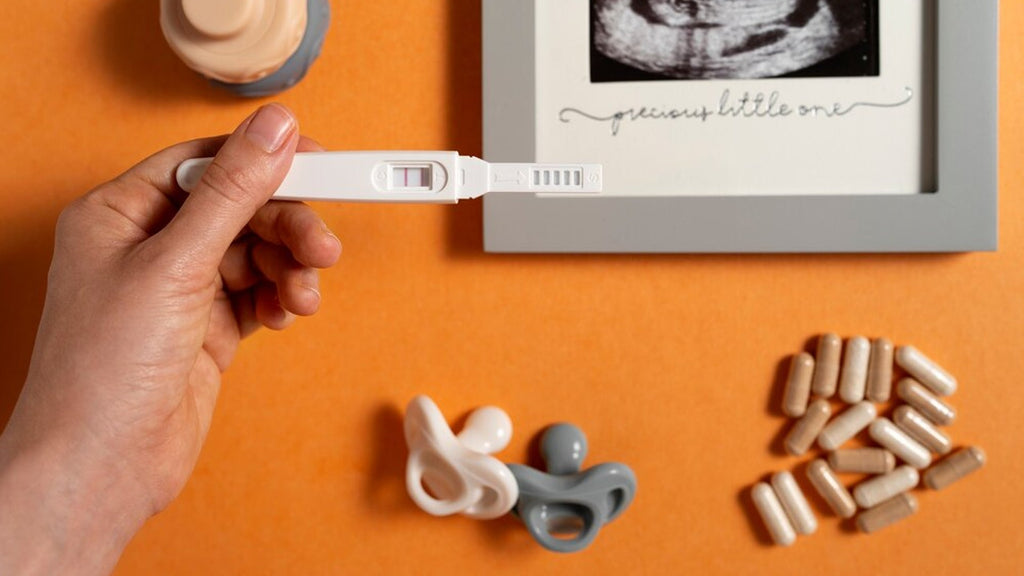
Embarking on Motherhood: Early Signs of Pregnancy
The journey of pregnancy begins even before the first missed period. This time can bring many changes and sensations in your body, some of which may be the first clues of pregnancy. In this blog, we'll delve into the very early signs of pregnancy and find out what you can expect during the first week after conception.
Understanding Early Stage of Pregnancy
The earliest stage of pregnancy involves a complex series of events. When the sperm fertilises the egg following conception, it travels down the fallopian tube and into the uterus. About a week after fertilization, it embeds itself in the uterine lining in a process called implantation, marking the true beginning of pregnancy.
6 Very Early Signs of Pregnancy
Every woman's body is unique, and so is her early pregnancy experience. Here are some of the earliest signs of pregnancy that you might encounter, even within the first week after conception:
-
Missed Period:
While a missed period is a classic sign of pregnancy, it may not be noticeable until after the first week. However, it's important to track your menstrual cycle to identify any delays or changes. -
Implantation Bleeding:
Occurring in about a third of pregnancies, implantation bleeding is one of the first signs. It happens around the time your period would normally start and appears as a light spot of blood. It's much lighter and shorter than a regular period. -
Cramping and Discomfort:
Similar to menstrual cramps, some women experience mild implantation cramps. These can feel like a light tug or a mild pricking feeling inside the abdomen. -
Breast Changes:
Early hormonal changes may make your breasts feel tender, swollen, or sore. Some women also notice that their breasts feel heavier and fuller, and the area around the nipples (areola) might darken. -
Fatigue
Surging hormones, particularly progesterone, can make you feel unusually tired. This hormone plays a key role in supporting the pregnancy but also causes tiredness. -
Nausea:
Often glamorized as morning sickness, nausea can actually occur at any time of the day. For some women, this begins within just a week after conception due to increased hormone levels.
How early do pregnancy symptoms start?
Pregnancy symptoms can start surprisingly early for some women. While the timing can vary greatly, some signs, like slight cramping or spotting, known as implantation bleeding, can appear as early as one to two weeks after conception. This happens around the time the fertilized egg attaches itself to the uterus wall. Other early symptoms such as breast tenderness, nausea, and fatigue might also develop soon after, prompted by increasing hormone levels. Typically, most women start to notice these changes a few days before their expected period or around two to three weeks after conception. However, every woman's body is different, and so the onset of symptoms can vary.
What to Expect in the First Week?
In the first week of pregnancy, most physical changes are internal and subtle. You might not notice any dramatic signs, but your body is beginning the vital work of growing a new life. Hormonal changes during this week lay the foundation for the pregnancy, affecting nearly every organ system in your body.
Emotional Impact
Discovering that you are likely pregnant can be overwhelming. It's natural to experience a whirlwind of emotions—from joy and excitement to anxiety and fear. It's important to acknowledge these feelings and discuss them with supportive partners, friends, or health professionals.
When to Take a Pregnancy Test
To acquire accurate results from a home pregnancy test, wait at least a week after you missed your period. These tests identify the hormone hCG, which your body produces only after implantation.
Next Steps After a Positive Test
If you've taken a test and it's positive, your next step should be to schedule an appointment with your healthcare provider. Getting early prenatal care is very important for a healthy pregnancy. Your doctor will help you with all the necessary steps, tests, and precautions.
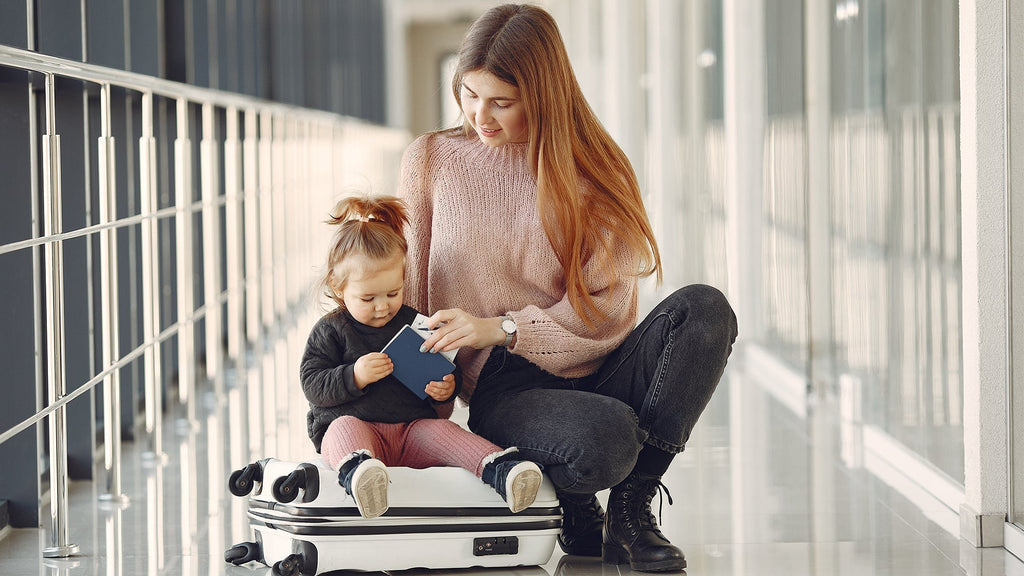
Top 10 Things to Know When Flying with a Baby
Flying with a baby can be a daunting experience, especially for first-time parents. However, you can make the trip easier and more enjoyable for you and your child if you prepare and follow these helpful guidelines. Here are the top 10 things to know when flying with a baby.
Top 10 Things to Know When Flying with a Baby
Flying with a baby can be a stressful experience, especially for new parents. With the right preparation and mindset, however, it can be smooth and even enjoyable. Below are the top ten things to keep in mind to make your journey easier.

1. Plan Ahead
Planning is crucial when flying with a baby. Book your tickets early to ensure you get the best seats for your family. If possible, choose flights that align with your baby’s nap schedule. This can help make the flight more manageable. Also, inform the airline if you need a bassinet or any other special accommodations.
2. Pack Smart
Less is more when it comes to packing, but you still need to ensure you have all the essentials. Here’s a checklist to help you pack smartly:
- Diapers: Pack enough diapers for the flight duration, plus a few extras.
- Baby Wipes: Essential for diaper changes and cleaning up spills.
- Clothing: Pack extra clothes for your baby like a baby bodysuit and a change of clothes for yourself.
- Blanket: A soft blanket can be useful for warmth and comfort.
- Feeding Supplies: Whether you’re breastfeeding, bottle-feeding, or have started solids, pack enough food and baby feeding bottles for the trip.
3. Arrive Early
Arriving at the airport early gives you ample time to handle unexpected situations. With a baby in tow, you’ll need extra check-in, security checks, and boarding time. Arriving early helps reduce stress and gives you time to deal with last-minute issues.
4. Choose the Right Seats
Selecting the right seats can make a significant difference in your travel experience. If possible, opt for bulkhead seats as they offer more legroom. Some airlines provide bassinets for babies in these seats, which can be a lifesaver on long flights. If bulkhead seats are unavailable, consider booking a window seat so you can have more privacy.
5. Keep Your Baby Comfortable
Comfort is key when flying with a baby. Dress your baby in comfortable, layered clothing to easily adjust to changing temperatures. A familiar blanket or toy can provide comfort and security. During takeoff and landing, feed your baby or offer a pacifier to help with ear pressure changes.
6. Manage Feeding and Hydration
Keeping your baby well-fed and hydrated is crucial. If you’re breastfeeding, take advantage of feeding during takeoff and landing to help with ear pressure. If you’re bottle-feeding, pack extra formula or milk. Don’t forget to bring snacks if your baby is old enough for solids. It’s also important to keep yourself hydrated, especially if you’re breastfeeding.
7. Navigating Security
Navigating airport security with a baby requires a bit of patience. You’ll need to carry your baby through the metal detector, so it’s helpful to use a baby carrier instead of a stroller. Liquids such as breast milk, formula, and baby food are allowed in reasonable quantities but will need to be screened separately. Be prepared for additional security checks for these items.
8. Handling Layovers
Layovers can be challenging with a baby, but with a little planning, they can be manageable. Choose airports that offer family-friendly amenities such as nursing rooms and play areas. Use layover time to feed, change diapers, and let your baby stretch. If the layover is long, find a quiet corner where your baby can nap.
9. Entertainment and Distraction
Keeping your baby entertained during the flight is essential to avoid fussiness. Pack a few of your baby’s favorite toys and introduce a new toy to capture their interest. Singing songs, reading books, and playing simple games can also help distract your baby. For older babies, a tablet with pre-downloaded baby-friendly videos or apps can be a great source of entertainment.
10. Stay Calm and Flexible
Traveling with a baby can be unpredictable, and things might not always go as planned. Staying calm and flexible is crucial. Babies can pick up on your stress, so try to stay relaxed. If your baby cries or becomes fussy, remember that it’s normal and other passengers are usually understanding. Focus on comforting your baby, and don’t be afraid to ask the flight attendants for assistance if needed.
Additional Tips
-
Travel Documents
Ensure you have all necessary travel documents for your baby, including a passport, if traveling internationally. -
Health Check
Consult your pediatrician before flying, especially if your baby has any health issues or if it’s your first time flying with them. -
Sanitization
Airplanes can be germ hotspots. Bring hand sanitizer and disinfectant wipes to clean surfaces around your seat. -
Car Seat
If you’ve purchased a seat for your baby, consider bringing an FAA-approved car seat for added safety and comfort. -
Boarding Last
Some airlines allow families with young children to board early. However, boarding last can be beneficial to minimize the time your baby spends on the plane.
Flying with a baby can be challenging, but with careful planning and a positive mindset, it can also be a rewarding experience. Remember, the key to a successful flight is preparation, patience, and staying flexible. Safe travels!


